No Results Found
The page you requested could not be found. Try refining your search, or use the navigation above to locate the post.
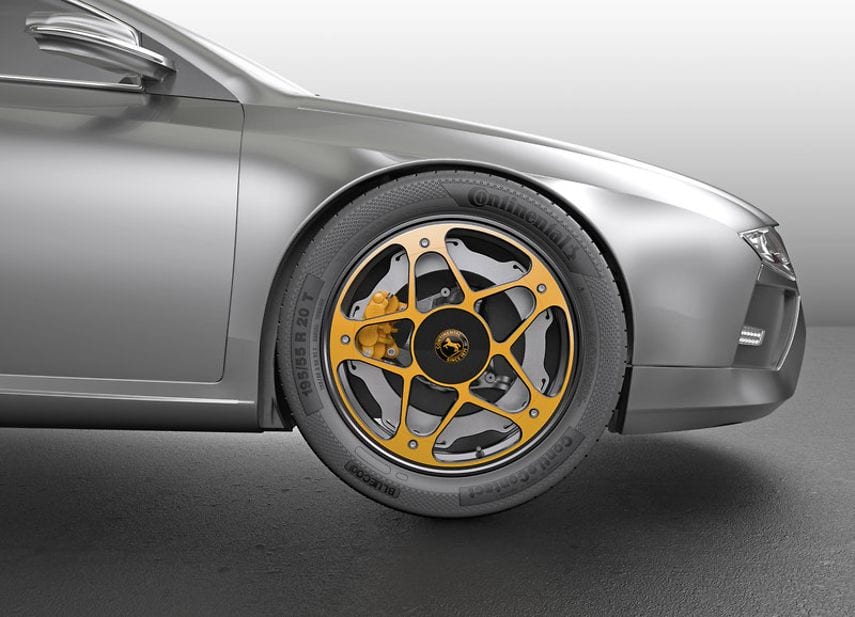
German Chancellor Angela Merkel this week reaffirmed her commitment to having 1 million EVs on the country’s road by 2020. In an interview with German YouTuber Lisa Sophie, Merkel reportedly said that the country has not abandoned its commitment to its one million EV goal by 2020 but that not enough was done up to now, signaling a possible ramp-up of the country’s efforts in the next two years. Merkel did not accept all of the blame for the slow pace but laid some of the responsibility on automakers which she doubts were sufficiently innovative enough to progress the technology.
Merkel will meet with local government officials on the 4th of Septemeber to discuss emission targets and indicated that around $600 million would be made available to improve urban transport infrastructure.
Although EV sales in Germany skyrocketed this year, the country so far only has just over 100,000 EVs registered. German EV sales data released this week showed that at the end of July nearly as much EVs have been sold as for the whole of 2016. EV sales in Germany are expected to continue its strong performance, supported by initiatives such as that of Nissan which announced that it would offer a scrapping bonus of EUR2000 ($2,348) for buyers converting from ICE vehicles to its Nissan Leaf or a Nissan e-NV200.
In related news, Chinese EV sales data showed a 30% rise in EV sales for the year to date over the corresponding period in 2016. It’s wattEV2buy’s forecast that China will reach its target of 2 million registered EVs by 2020, and even exceed it as more models become available in the next two years. China is already standing more than 800,000 units of which 200,000 has been registered this year alone. It is our belief that the Chinese EV market is set to reach its one million EV milestone by the end of the year, in light of historically stronger second half sales.

The Indian power producer, JSW Energy, a thermal power producer with nearly 5,000 MW of capacity is set to shift its business to align itself with more sustainable energy offering. Although this strategy is adopted by most power producers JSW Energy’s shift is more radical, as it includes investing around $550 million in new businesses including the manufacturing of an electric vehicle by 2020. In an interview with the Hindu BusinessLine, JSW Energy’s CEO admitted that the company is venturing into a new competitive space but that it bets on the growth in the vehicle sector in India due to the expected disruption by EVs. The company is set to work with technical partners and have a 60% local content goal.
As the rush to EVs starts to accelerate auto part companies are investing more and more in the development of new technologies, helping to advance electric vehicles. The Korean auto part company, Hyundai Mobis, this week announced that its the first South Korean company to develop a bi-directional on-board charger (OBC) for vehicle-to-grid (V2G) applications. Industry commentators have been quick to claim EVs V2G capability as a key attribute of the technology, but to date, no production vehicle comes equipped with the application as a standard feature. A contributing factor for the slow adoption of V2G technology is the slow development of software to optimise the charging / depleting of batteries so that drivers are not left stranded due to supplying the grid with power.
Other technology advancements unveiled this week include the German auto parts company, Continental, introducing a new lightweight wheel and braking concept for EVs. In a press release by the company highlighted the technology as follows:
As the push for cleaner cities drives the EV revolution forward, we are seeing more and more electric delivery vans entering the marketplace. Gone are the days of an EV delivery van being associated with the defunct Azure Connect or the small Renault Twizy Cargo which hardly had enough space or range to cover the average daily distance for delivery vehicles of 65 miles. The past month has seen the introduction of production versions of the Daimler Fuso E-Cell and the new Renault Kangoo ZE. This week two more delivery vehicles made the front pages. Ford and Deutsche Post subsidiary, Street Scooter, this week introduced its first jointly produced E-Van, the StreetScooter Work XL in Cologne. The Work XL is based on the Ford Transit Van and has a load capacity of 20 cubic meters, a modular battery system that could be sized from 30kWh to 90kWh for a range of between 80km and 200km. The 22kW onboard charger allows for an average charging time of three hours. Each WORK XL could save around five tonnes of CO2 and 1,900 liters of diesel fuel each year. StreetScooter will assemble around 150 units by the end of 2017 at its Aachen plant and ramp up to 2,500 units by the end of 2018. The Deutsche Post DHL Group is the largest operator of electric vehicles in Germany with a fleet of 3,000 StreetScooter Work and Work L vans and 10,500 pedelecs.
In the US, Chinese owned and Californian based EV start-up, Chanje, announced that it would introduce its first medium size fully electric delivery vehicle, the V8070 by the end of the year. The V8070, below on the right, has a 100-mile range with a 6,000lbs payload and 7.2kW onboard charger. Chanje has raised funding of $1 billion from various partners including Hong Kong-based FDG Electric Vehicles Limited which manufacturers the Yangtze EV in China.
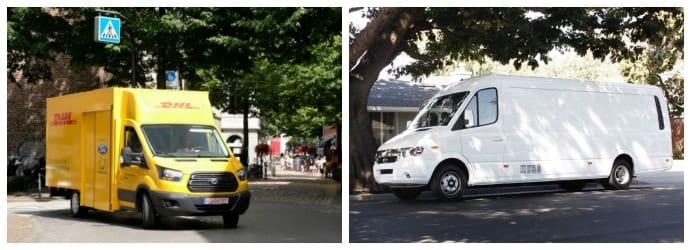
As the race for electric vehicles hots up so it does for autonomous vehicles as car makers try and regain the edge it lost in the EV sector to tech start-ups. Fiat Chrysler Automobiles (FCA), dead-last in the EV race, this week joined the BMW Intel self-driving car alliance as the company gears-up to produce self-driving cars by 2021. The BMW led alliance also includes Intel’s recently acquired Israeli tech company, Mobileye, Delphi Automotive, and Continental. Together the alliance will have 140 self-driving test vehicles on the roads by the end of 2017. Interestingly enough FCA is also a partner with Google’s Waymo where it developed and deployed autonomous Chrysler Pacifica minivans.
The Michigan Economic Development Corp funded American Center for Mobility announced that it will start operating its autonomous vehicle testing ground in December 2017. The converted Willow Run facility, first used for airplane testing, is a two-and a half-mile highway test loop. Michigan, which has been one of the pro-active states in self-driving development invested around $110 million in the conversion and expects to develop a second facility by 2019 to represent urban driving conditions.
US Chipmaker, NVIDIA, which led the push into autonomous technologies ahead of its competitor Intel, this week announced its investment in two-year old Chinese self-driving truck start-up TuSimple. The undisclosed investment by NVIDIA was part of $20 million funding round led by Sina, the Chinese Social Media company. TuSimple recently completed a Level 4 autonomous trip from San Diego to Yuma, Arizona.
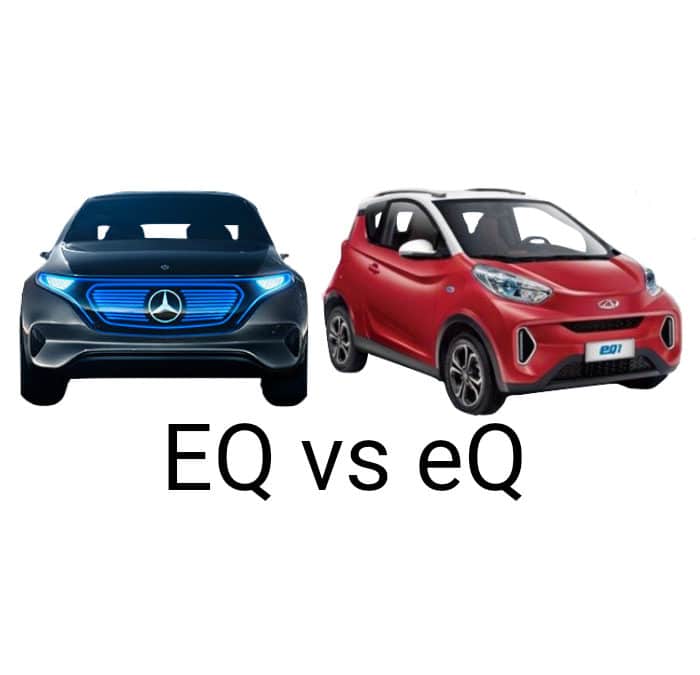
Mercedes Benz and Chery Automotive reached an agreement in the trademark dispute lodged (EV News Week 12) by Chery in March 2017. According to a joint press release, the companies agreed to the following settlement with regards to using the EQ designation for electric vehicles in China:
Chery will focus on using the designations eQ and eQ1, as well as further numerical continuations thereof, while Daimler will focus on use in their electric Mercedes-Benz products with the designations EQC and any other alphabetical supplements. Daimler will use the EQ Power designation for Plug-In Hybrids and meanwhile Chery will also use eQ TEC to nominate their car electrification system.
Chery has already been using the eQ and eQ1 brand names in China since year 2014 and Daimler has now also granted them the possibility to use this name family in countries outside of China. Daimler established the EQ brand family for electrically driven Mercedes-Benz vehicles almost simultaneously in countries outside of China and Chery has granted the company the possibility to also use this in China now.
We reported in March that BMW was considering Mini as an EV only brand, with the Mini being its answer to Tesla and Chevrolet‘s mass market cars, the Model 3 and Bolt EV. At the time BMW CEO, Harald Krüger was quoted that the company is considering manufacturing facilities for the Mini in Germany, the Netherlands, and the UK. Reuters this week reported that unconfirmed sources indicated that the UK would be the winner in the race for producing a fully electric Mini. The BMW plant in Oxford is responsible for 60% of the Groups compact cars, but in the aftermath of BREXIT, the German automaker established the Netherlands as an alternative manufacturing base. The report indicates that the final desition will be announced at the Frankfurt Auto Show in September.
As the June EV sales data are being released, we have been able to create half year reports for the key markets. Most of the of the key markets are showing exceptional growth in the first half of 2017. The increased sales are helped with the release of a slew of new models. As many as 20 new models have entered the Chinese EV market since June 2016 while most European markets saw ten or more new models. Some of the highlights are:
Germany – Year on Year growth of 104% or 11,000 units
USA – Year on Year growth of 39% or 25,000 units – see report
China – Year on Year growth of 35.8% or 44,000 units – see report
Norway – Year on Year growth of 20.6% or 4,600 units – see report
Sweden – Year on Year growth of 35.2% or 2,100 units – see report
France – Year on Year growth of 1.4% or 260 units
Netherlands – Year on Year growth of -14.2% or shrinking with 656 units
Smaller markets such as Spain has also shown growth of 101% and Italy 53%. We will be releasing detailed reports on all the Top 10 countries in the following two weeks.
Nissan announced that the new Nissan Leaf would be released on the 6th of September. New EV model releases have become as anticipated and high profile as smart phone releases some years back. With the date nearing Nissan has been releasing teasers about the long awaited new Nissan Leaf. The latest teaser revealed that the Leaf would have an e-Pedal, or for the novice, just one pedal to accelerate and break. Breaking is done by taking your foot off the pedal, activating regenerative breaking. The technology was first used in the Tesla Model S and then in the BMW i3 in 2014. Previous teasers indicated that the Leaf would have some autopilot functionality.
The Swedish carmaker, Volvo, and the Chinese company, Geely is fostering deeper relationships in the worlds largest market for electric vehicles. In a press release by Volvo this week it was revealed that the companies would establish a new joint venture technology company to share existing and future technologies. We have seen this cooperative trend in China for the last couple of months, which is a departure from previous JVs between international and Chinese companies. In the past international automakers were forced by law to enter into JVs with Chinee companies to be able to sell their vehicles, which lead to mostly older generation models being dished up to the Chinese consumer as the international partners tried to protect their IP.
The JV company will be owned 50/50 by Geely and Volvo with its HQ in China and a subsidiary in Gothenburg, Sweden. The Memorandum of Understanding agreed to on the 20th of July between Volvo, Geely and newly formed LYNK & CO determined that the companies will share vehicle architecture and engine technologies via cross licensing arrangements of technologies managed by the new joint venture. The IP for the technology will remain with the company that developed it, but the technology itself will be available for use by Volvo, Geely Auto, and LYNK & CO, via license agreements. Volvo Cars and Geely already share technology, most notably the Compact Modular Architecture (CMA) which is being used by Volvo Cars for its soon-to-be-announced smaller range of 40 series cars and by LYNK & CO.
Separately, it is also announced that Volvo will acquire a minority shareholding in LYNK & CO.
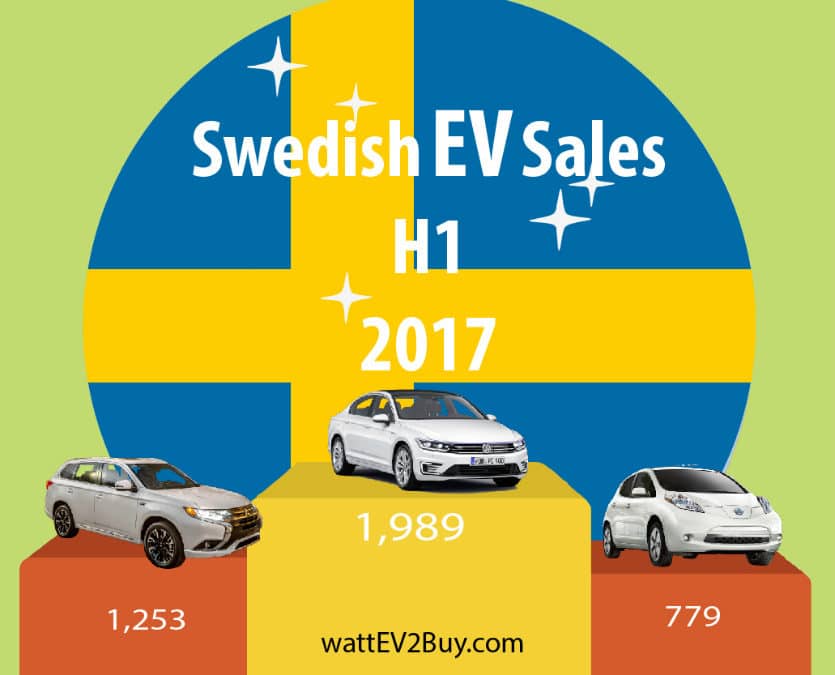
We look at the Top brands and models, the gainers and losers and how the battle between battery electric (BEV) and plug-in hybrid (PHEV) technologies play out in the summary of Sweden EV Sales H1 2017.
The highlights for Swedish electric car sales in H1 2017 was:
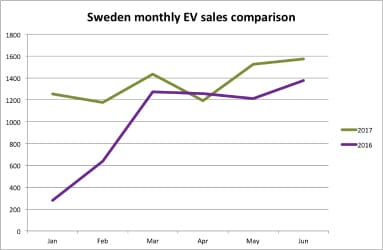
The Top 3 EV brands in Sweden for H1 2017 were VW, new entrant Mitsubishi and BMW. Most EV brands except Volvo and Peugeot showed gains in units sales compared to H1 2016. Hyundai entered the Swedish market with its Hyundai Ioniq BEV. Initial sales for the Ioniq was below average in a market which has a preference for plug-in hybrid electric vehicles. Toyota re-entered the market with the new Prius but failed to get the same traction as it did in other markets. Tesla and Mitsubishi nearly doubled their sales from 2016. Sweden is on of the few markets where Mitsubishi showed positive growth with the aging Mitsubishi Outlander PHEV in 2017 and now makes up 23.24% of all EV registrations in Sweden. BMW maintained its third overall position with the support of its 330e, 225xe, and X5 xDrive models, more than compensating for waning sales in the BMW i3 model series. VW held on to the top spot, mostly due to the VW Passat GTE which accounted for 25% of all EV sales in Sweden during H1 2017.
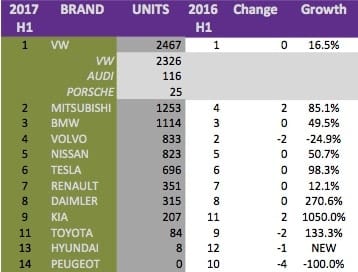
Ten new EV models entered the Swedish EV market in the comparison between H1 2016 and H1 2017. Of the ten new EV models, eight were plug-in hybrids, and only the Tesla Model X made it on to the Top 10 list. Volvo launched two new plug-in models at the end of May in its home market, the Volvo XC60 T8 and Volvo S90 T8 PHEV. The XC60 sold 44 units and the larger S90 31 units. The Nissan Leaf still performed well considering the upgrade is expected early 2018. Most of the Mercedes-Benz models fared well except for its larger S550 and GLE550 models. The Daimler company could however not compete with its compatriot, BMW, who had more models in the smaller end of the scale. The BMW 330e, BMW i3, and BMW 225xe Active Tourer sold 813 units while the Mercedes-Benz B250e and Mercedes-Benz C350e could only muster a combined 130 units. The Tesla Model S still performed well in Sweden as opposed to the general trend where we see the sales flattening out in its main markets.
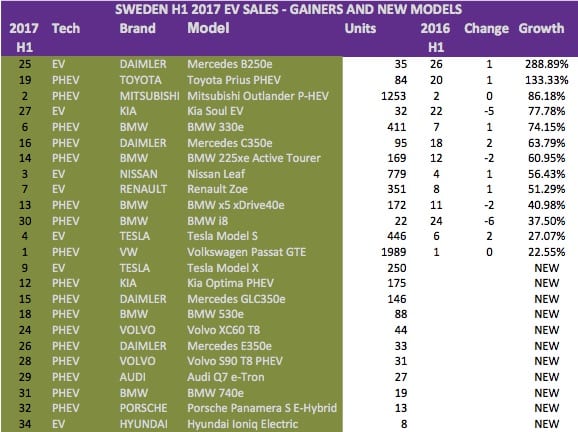
Volvo was the big loser in Sweden during the first half of 2017 despite having a home ground advantage and bringing two new models to market, albeit only in late May. Volvo’s two mainstay plug-in electric cars, the Volvo XC90 T8 and Volvo V60 PHEV, lost nearly a third of their respective sales to brands such as VW, BMW, and Mercedes-Benz.
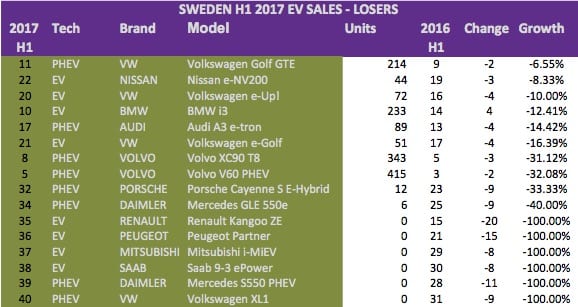
Sweden has a definite preference for plug-in hybrid electric vehicles. Of the ten new models released since the first half of 2016 in Sweden, eight were PHEVs. A total of 5,850 plug-in hybrid vehicles were sold, comprising 72% of the market while only 2,301 pure electric models were sold during the same period. The percentage breakdown of PHEV to BEV in H1 2017 is very similar to that of H1 2016, explaining why most new models released in Sweden were PHEVs despite a halving of the rebate on plug-in hybrids.
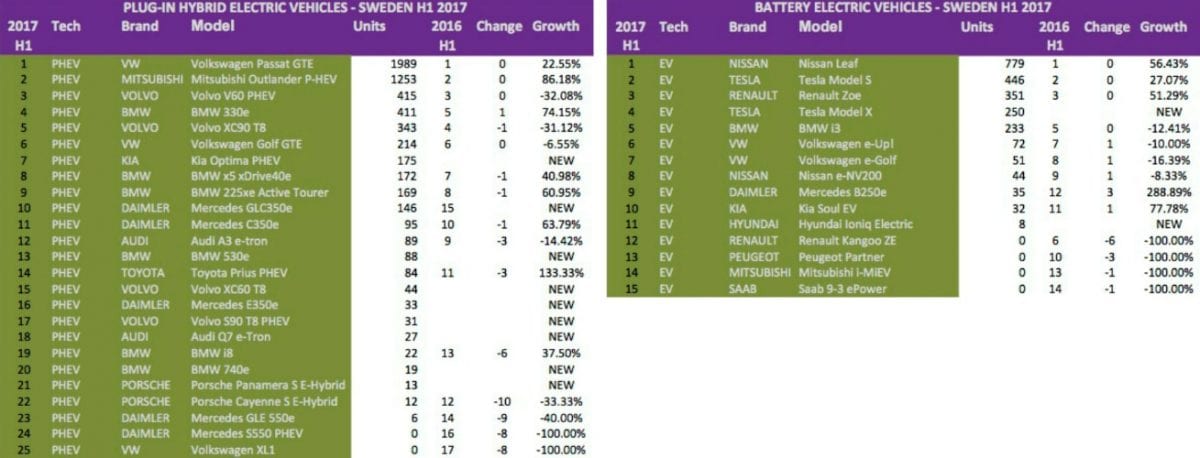
In conclusion, even at a 3.4% of the national fleet (Q4 2016), electric vehicle sales in Sweden remains low compared to its neighbor Norway, which has an EV penetration of close to 30% (Q4 2016). The sluggish performance is linked to the Swedish EV incentive program which has been erratic, linked to a fixed amount of funding which has been depleted a couple of times. Also, the Swedish EV buyer does not get his/her rebate at the point of sale. The Swedish Transport Agency contacts owners after the purchase of the vehicle requesting the completion of a paper process after which they receive the rebate. The rebate of 40,000 kroner (~ $4,500) applied to BEVs and PHEVs up to October 2016 at which time it was halved for PHEVs.
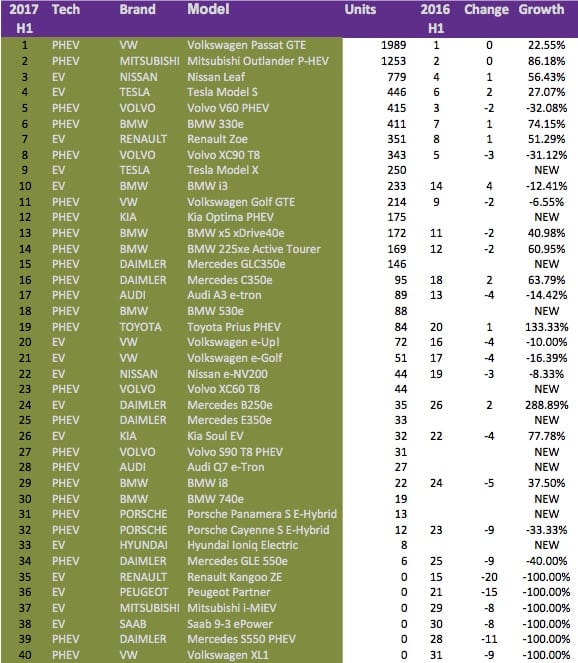
Base data supplied by EV Sales, all calculations, and data representations by wattEV2Buy.
Be sure to check out our new presentation of all EVs since 2010 to gain great insights on all auto brands and their electric vehicle strategies. We have also created presentations per technology type BEV, PHEV, and FCEV.
The page you requested could not be found. Try refining your search, or use the navigation above to locate the post.
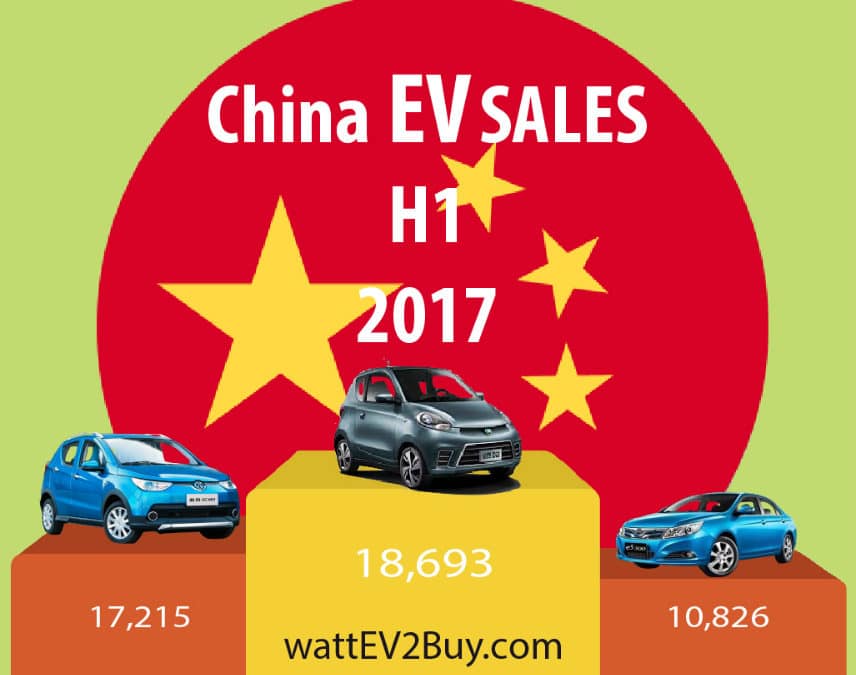
We look at the Top brands and models, the gainers and losers and how the battle between battery electric (BEV) and plug-in hybrid (PHEV) technologies play out in the summary of China EV Sales H1 2017.
The highlights for Chinese electric car sales in H1 2017 was:
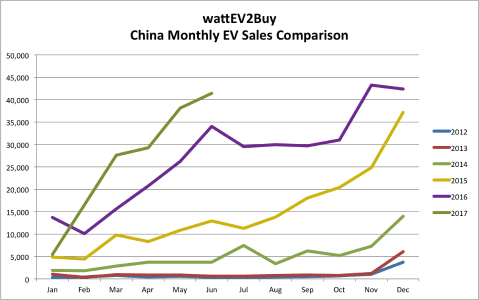
The Top 3 EV brands in China for the first half of 2017 were BYD, BAIC, and Zhidou. Although BYD hung on to its first place, it sees its lead evaporate. BYD hardly registered any sales in the January 2017, and lost sales in its top performing Qin and Tang model ranges to competing new models from BAIC, Chery, and SAIC Roewe. BYD, one of the largest EV brands in the world, is seeing its position as China’s best performing EV brand challenged as it lost over 20% of its sales compared to 2016, while its competitor BAIC more doubled its sales. BAIC benefited from exciting new models entering the market in the last 12 months, with its small hatch, the BAIC EC180 being a top performer for three of the six months ending up the second best selling EV for the semester. Smaller EVs, or City cars, have also performed very well with the popular Zhidou Geely D2 selling nearly 20,000 units. Another brand with small EV models, Zotye, was placed fourth due to the popularity of its Cloud 100, E200 and E30 models. Other Top 10 Chinese EV brands selling city cars included Chery and JMC, both placed in the Top 10. Although JAC brought the exciting JAC iEV6S small SUV to market it was not enough to withstand the onslaught of its peers, crashing out of the Top 3 to the eight position. Tesla also entered the Top 10 list with the Model X performing very well (please note the June 2017 Tesla data did not make it in time for our analysis, which would have aided the brand’s performance). Western brands such as Volvo, BMW through its local partner BMW Brilliance, Daimler and GM mostly gave up market share to Chinese-produced vehicles.
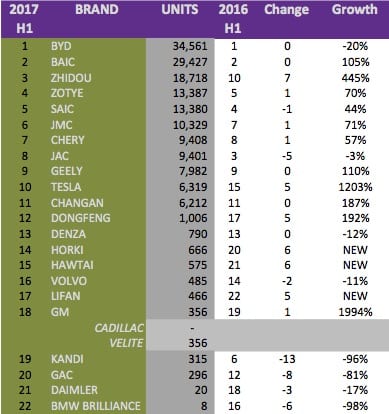
Twenty new EV models entered the Chinese EV market in the first half of 2017 but only three, the BAIC EC180, SAIC Roewe eRX5 and BYD Song DM, made it to the Top 10 list of electric vehicles in China. None of last years Top 5 could hang on to their positions with two of the new models, the BAIC EC180 and SAIC Roewe eRX5, entering the market with Top 5 positions within three months from being launched. Last year’s Top 3 EVs, the BYD Tang, BAIC E200, and BYD Qin all crashed out, with the BYD Tang the only model able to hold on to a Top 10 position. Plug-in Hybrid vehicles could only muster three positions in the Top 20 as small city EVs made up more than half of the units sold in 2017 to date. The popular SUV class accounted for 26% of the units sold in the Top 20 list of EVs in China while plug-in hybrids only accounted for 16% of all the EVs sold. New electric vehicle models made up 31% of all the EVs sold during the period under review.
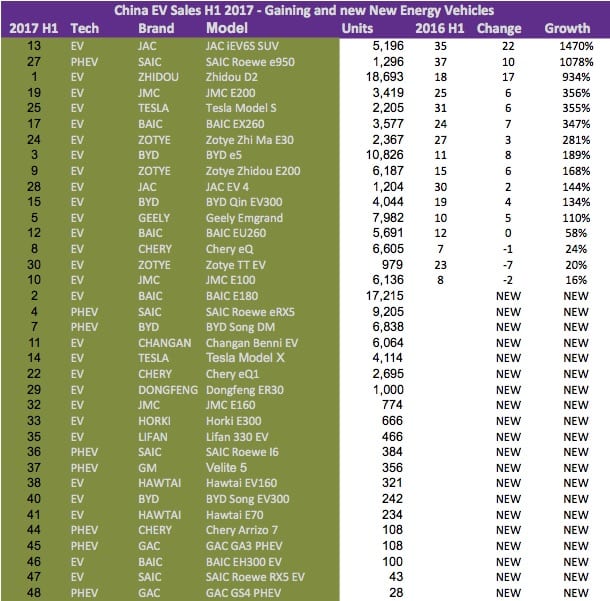
BYD’s ailing fortunes are clear in the list of losers for the first half of 2017 but another popular EV brand from 2016, Kandi, saw diminishing sales as its Kandi K17 Cyclone could not compete with the host of new small city cars entering the Chinese EV market. Clear again is the composition of plug-in hybrids and foreign brands in the list of the worst performing electric cars.
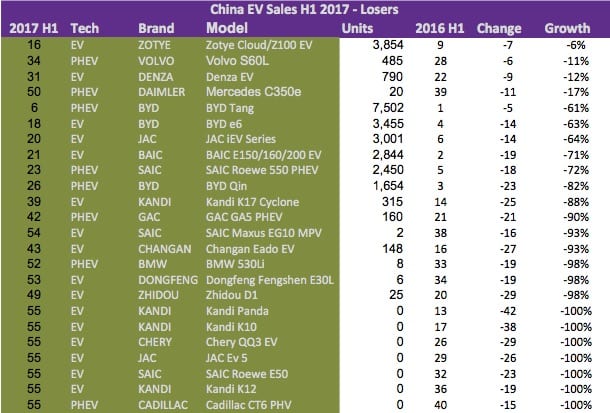
Plug-in hybrid models are losing the battle in China, strange though that 35% of the new models launched in the last 12 months are PHEVs. In the comparable period in 2016 plug-in electric vehicles made up 33% of all the units sold while the vehicle type only contributed to 16% of all sales in 2017.
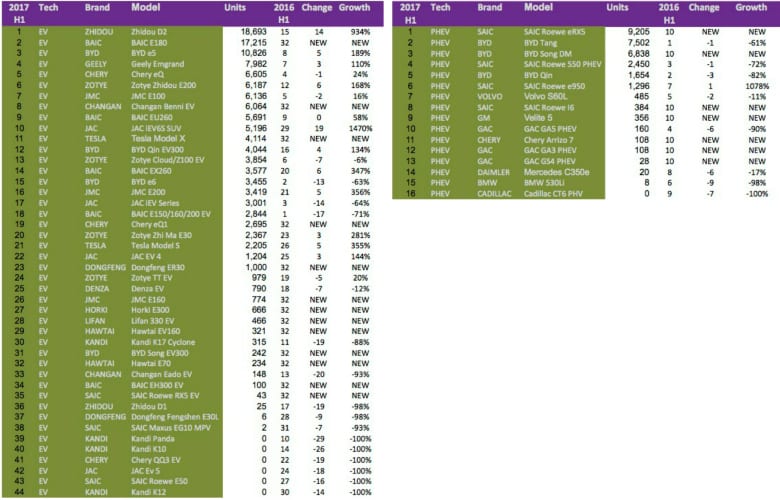
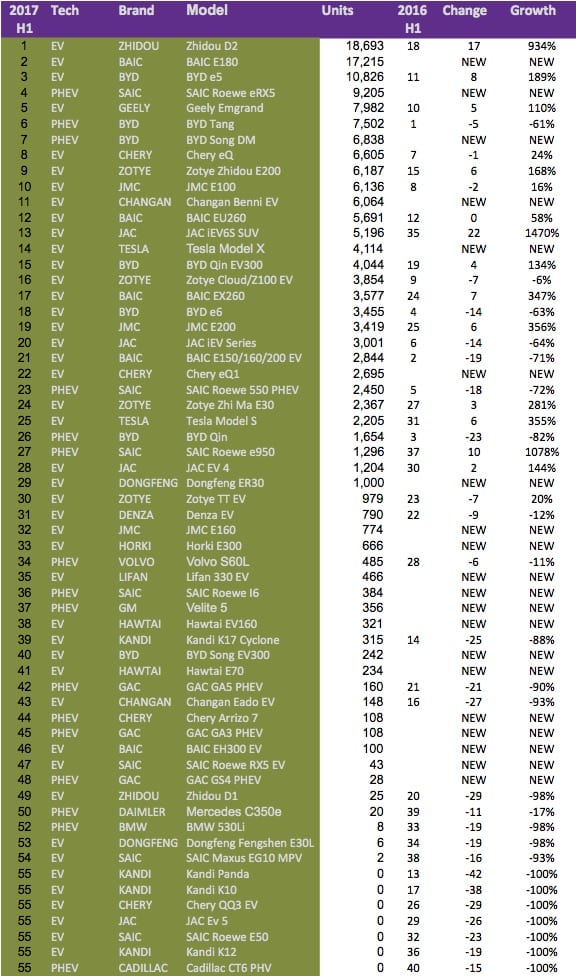
Be sure to check out our new presentation of all EVs since 2010 to gain great insights on all auto brands and their electric vehicle strategies. We have also created presentations per technology type BEV, PHEV, and FCEV.
The page you requested could not be found. Try refining your search, or use the navigation above to locate the post.
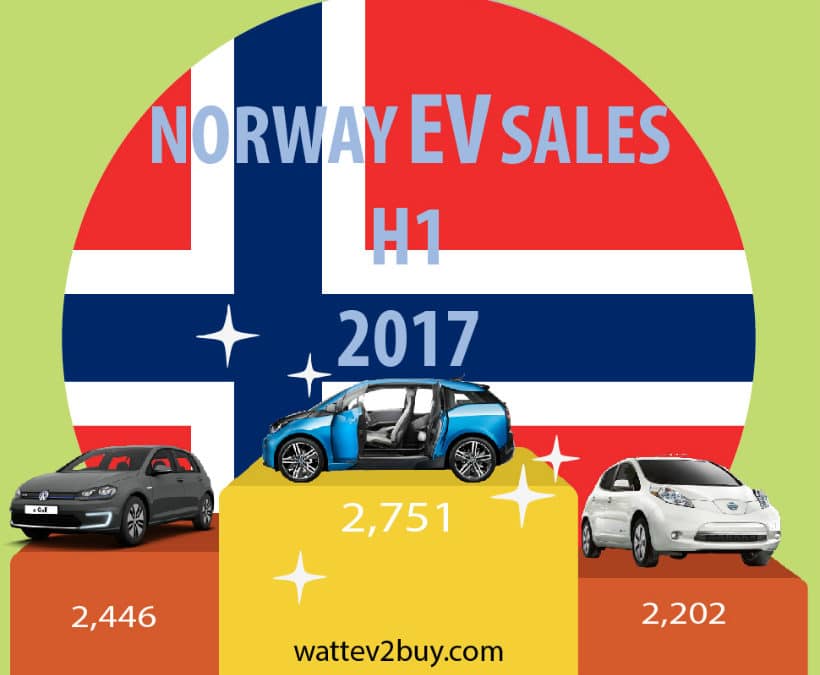
We look at the Top brands, Best and Worst Models and how the battle between battery electric (BEV) and plug-in hybrid (PHEV) technologies play out in the summary of EV Sales in Norway H1 2017.
The highlights for Norwegian electric car sales in H1 2017 was:
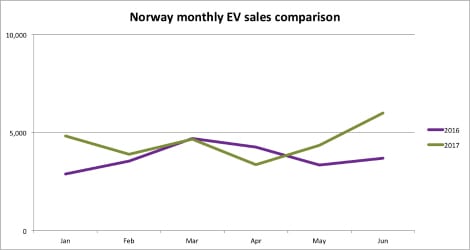
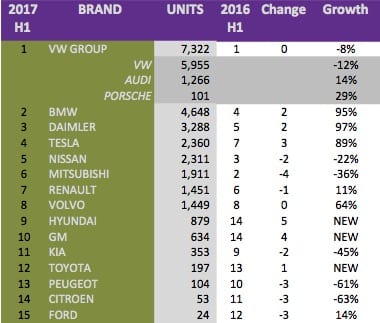 We saw very big changes in the Top 3 electric vehicle brands in Norway with only VW Group retaining its Top position, albeit with lower sales in its mass-market VW brand. Japanese automakers, Mitsubishi and Nissan were pushed from the Top 3 by German luxury automakers BMW and Daimler. Tesla sales also surpassed that of Mitsubishi and Nissan, with a strong performance by the Tesla Model X more than offsetting the slide in Tesla Model S sales. Tesla now commands over 11% of the total EV market in Norway.
We saw very big changes in the Top 3 electric vehicle brands in Norway with only VW Group retaining its Top position, albeit with lower sales in its mass-market VW brand. Japanese automakers, Mitsubishi and Nissan were pushed from the Top 3 by German luxury automakers BMW and Daimler. Tesla sales also surpassed that of Mitsubishi and Nissan, with a strong performance by the Tesla Model X more than offsetting the slide in Tesla Model S sales. Tesla now commands over 11% of the total EV market in Norway.
French automakers Renault, Peugeot and Citroën gave up positions to their peers as Hyundai and GM entered the market with the new Ioniq and Opel Ampera-e (Bolt EV) mass-market EVs. It is disappointing that first movers such as the PSA Group grew too comfortable supplying the same models for the past 5 years without preparing a response to longer range mass-market vehicles. Toyota has not achieved the same stellar sales in Norway with the new Toyota Prius as it did in some of its other markets.
The Top 10 gainers in sales growth over 2016 were mostly plug-in hybrid vehicles (PHEV) while the top selling vehicles by units were mostly battery electric vehicles (BEV). The BMW i3 rose a healthy eight positions and ate into the sales of the VW e-Golf, VW e-Up, VW Golf GTE, Audi A3 e-tron, and Nissan Leaf. Norway is now the second best market, after the USA, for the German manufactured BMW i3 accounting for 8% of all electric vehicles on the country’s roads. The Tesla Model X performed very well, helping Tesla to nearly double its sales in Norway. The rise of the Model X, now the best performing luxury EV in Norway, came at the expense of the BMW X5 xDrive and Mitsubishi Outlander. Luxury brands Daimler and BMW‘s large selection of PHEV models performed well in Norway with the Mercedes GLC350e helping Daimler to be the leader in the luxury class over BMW. It is only Daimler’s lack of an answer to the BMW i3 that kept the automaker in the third spot overall.
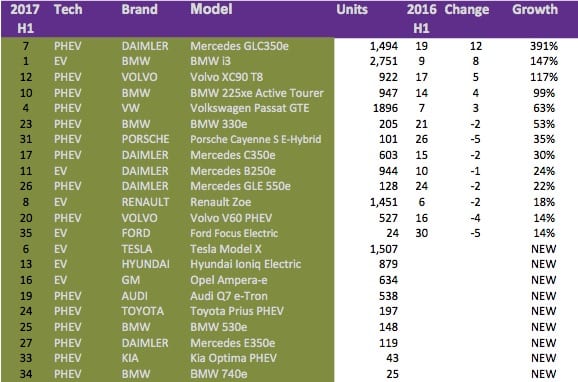
The VW brand sold 1,540 units less than last year across the VW Golf GTE, VW e-Golf, and VW e-Up models. The VW Group lost nearly 2,000 units in total if one should factor in the sales loss from the Audi A3 e-tron. The biggest overall loser was the Mitsubishi Outlander PHEV which sold 1,040 units less than the same period in 2016. The Tesla Model S is following the same trend as we see in many other countries, losing 31% or selling 388 units less than last year.
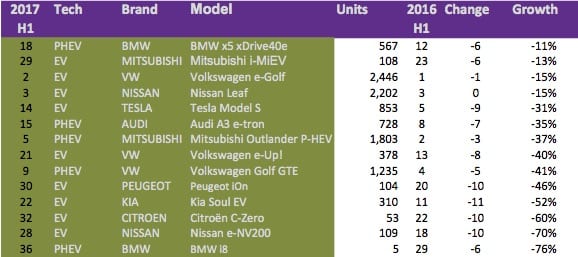
Pure electric vehicles (BEVs) extended their lead over plug-in hybrid vehicles (PHEV) to 20.6% from 17.3% in H1 2016 despite having fewer models to offer. A total of 14,753 BEVs sold in the first-half of 2017 in Norway compared to 12,231 PHEVs. For our calculation, we included the BMW i3 REx as a BEV since we don’t have an accurate breakdown of BMW i3 sales between the BEV and range extended version.
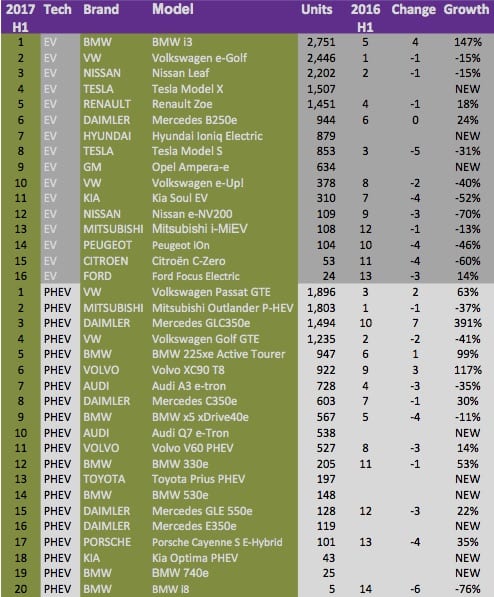
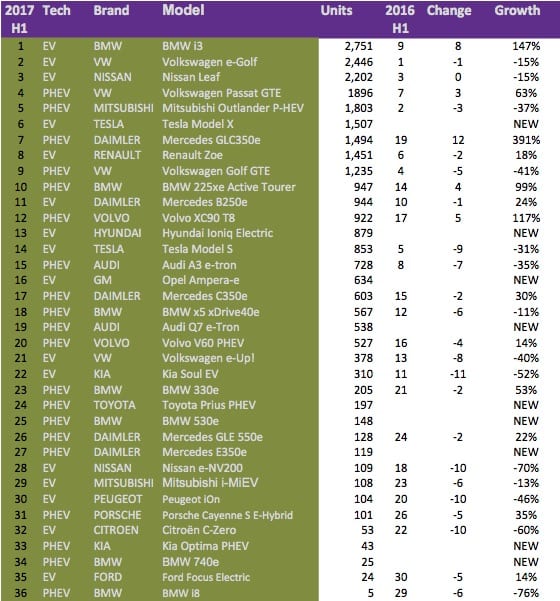
Be sure to check out our new presentation of all EVs since 2010 to gain great insights on all auto brands and their electric vehicle strategies. We have also created presentations per technology type BEV, PHEV, and FCEV.
The page you requested could not be found. Try refining your search, or use the navigation above to locate the post.
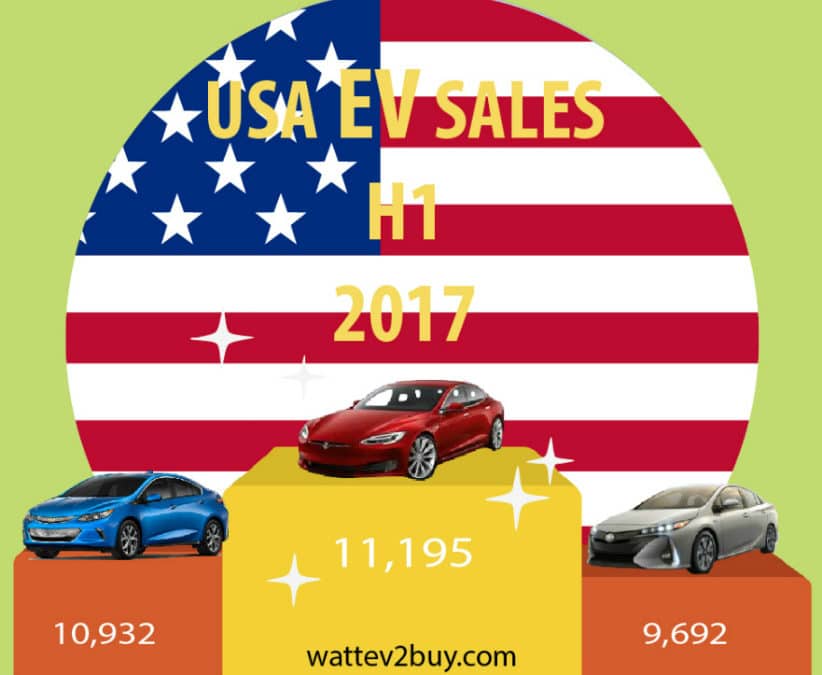
We look at the Top brands, Best and Worst Models and how the battle between battery electric (BEV) and plug-in hybrid (PHEV) technologies play out in the summary of USA EV Sales H1 2017.
The highlights for USA electric car sales in H1 2017 was:
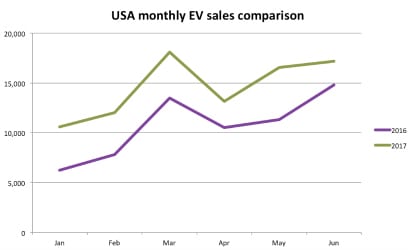
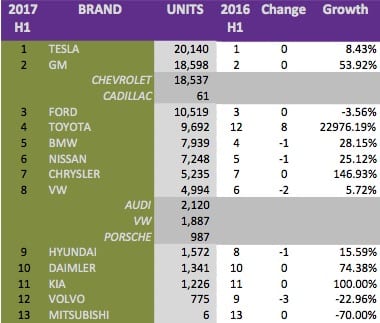
There are no surprises in the Top 3 EV brands with Tesla holding on to its lead over GM due to a 24% rise in Tesla Model X sales. GM could not dethrone Tesla even with a new model, the mass-market Chevrolet Bolt EV up its sleeve. Improved sales in the 2nd Quarter from the Ford Fusion Energi and C-Max Energi helped the brand retain its third position fighting off the strong performance of Toyota with the new Toyota Prius which was placed third at the end of the first quarter.
Most brands showed improved sales growth over the first half of the year with only Ford, Volvo, and Mitsubishi showing declining sales. The Volkswagen Group showed a declining trend as the year progressed and mustered the lowest growth. The declining fortunes of the German automaker can be attributed to the Volkswagen e-Golf not being able to compete on range with the new mass-market Chevrolet Bolt being sold in the same price bracket. Chrysler showed the highest growth after Toyota buoyed by the new Chrysler Pacifica and great specials on its compliance car, the Fiat 500e. The results might have been better for the US automaker, but the Chrysler Pacifica launch was delayed and then impacted by recalls and plant closure due to battery problems.
Most of the existing models showed growth lower than the overall growth due to the big number of new models to the market. Surprisingly the Ford Focus and Fiat pure electric models outperformed the market showing that the public is becoming more comfortable with range issues and the continuously improving charging infrastructure is starting to have and effect on top of the financial incentives making EVs appealing.
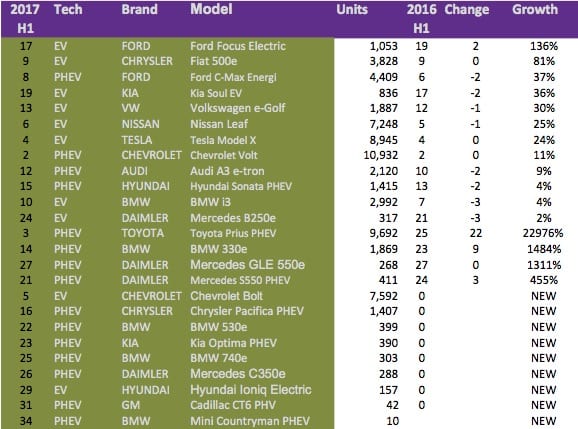
European plug-in vehicles were the biggest losers in this half of 2017 with a number of the luxury PHEV models losing big. Volvo and BMW saw some of their relatively new models losing steam. Both the BMW x5 xDrive and Volvo XC90 T8, released in 2016, lost market share in favor of the Tesla Model X. The Tesla Model S sales have flatlined although it remained the top selling BEV model. It will be interesting to see how the new Daimler Smart ForTwo ED fares in the second half of 2017. The German automaker is relaunching the brand as electric only in the USA and Canada from this summer and will offer a slightly improved model at a marginally reduced $23,800 starting price before incentives.
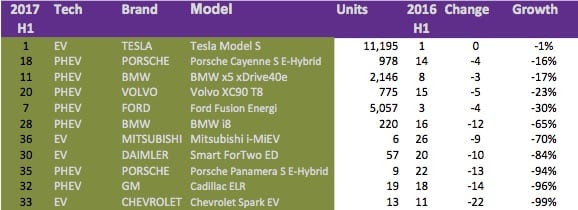
Battery electric vehicles are still maintaining its lead over plug-in hybrids albeit at a lower margin. BEVs took six positions in the Top 10 EV sales for the USA in the first half of 2017. The ever increasing number of plug-in models benefits the technology in the short term as it competes with only a handful of pure electric models. The Plug-in hybrid category benefited mostly from the release of the new Toyota Prius and to a lesser extend the Chrysler Pacifica. The Tesla Models X and S constitute nearly 44% of all BEV models showing the company’s dominance in the sector. The commanding position will improve even more with the release of the Model 3 in the second half of 2017 which might add about 40,000 units depending on the production ramp-up. The release of the Tesla Model 3 and new Nissan Leaf, expected by the end of the year, should help pure electric vehicles outperform the more dirty plug-in hybrids in the second half.
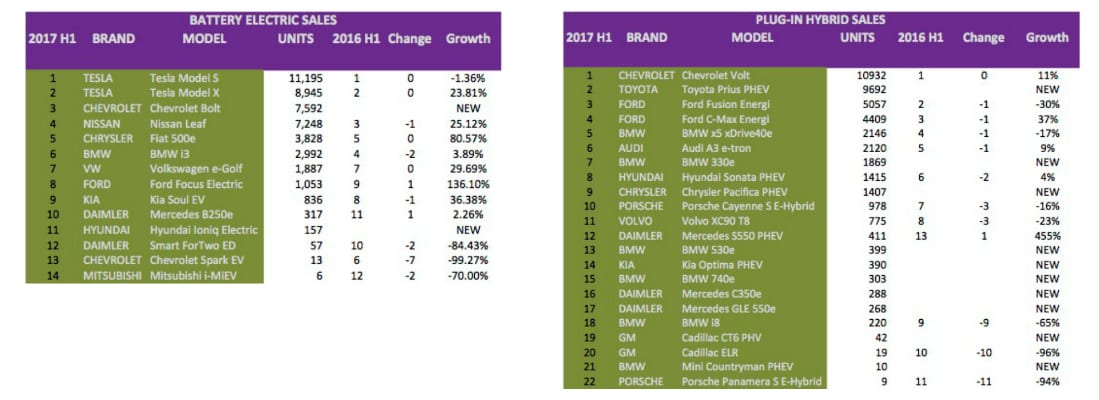
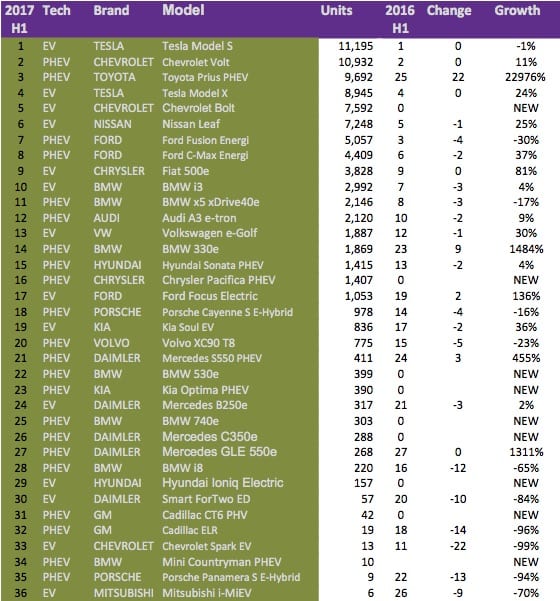
Be sure to check out our new presentation of all EVs since 2010 to gain great insights on all auto brands and their electric vehicle strategies. We have also created presentations per technology type BEV, PHEV, and FCEV.
The page you requested could not be found. Try refining your search, or use the navigation above to locate the post.
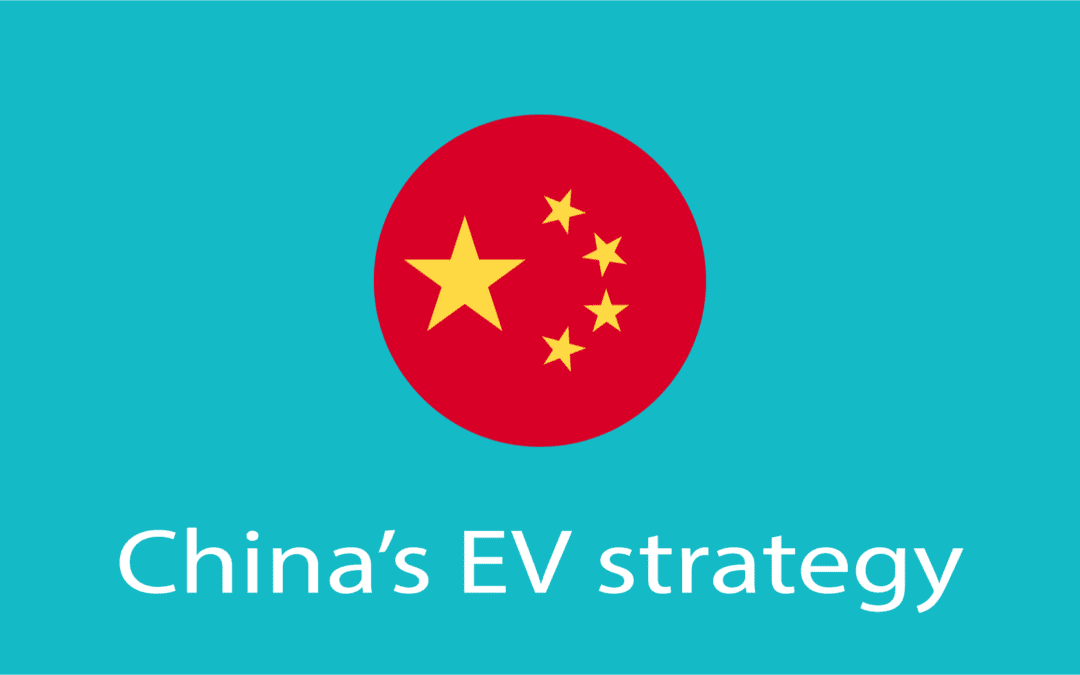
Bloomberg released an unconfirmed report on Tuesday that the Chinese Government would place a moratorium on the release of EV production certificates as the country tries to manage the sustainability of the sector. Although the report remained unconfirmed at the time of going to press shares of automakers with issued permits rallied on the news.
In 2016 the Chinese Government announced that it would limit the number of EVs produced by regulating the sector through the issue of production certificates. The National Development and Reform Commission (NDRC), a body that oversees investments in the centrally managed economy, announced that only ten permits would be issued to produce EVs. At the time a much as 200 companies, including 30 IT companies, had business plans to profit from the government’s program to promote electric vehicles. It was estimated that the anticipated production would far exceed 50 million units per year. The Government further feared that the rush of newcomers to the industry would lead to inferior products harming the sustainability of its strategy to dominate the EV sector.
In May 2017 I published an article on the permitting process and the products and strategies of companies with issued production certificates. At the time Shenzhen GreenWheel received the 14th permit, allowing the company to produce 50,000 per annum. Since then a 15th permit, possibly the last for the foreseeable future, was issued to the newly formed JAC/VW joint venture, granting a production certificate of 100,000 per annum.
The Chinese Government targets to add 2 million new energy vehicles to the national fleet per annum by 2020. In 2016 the country sold more than 500,000 taking the total of EVs on the country’s roads to over 800,000 units. Should the report hold true, it leaves the question what would happen to the business plans of companies such as LeEco and NextEV with much-publicised intentions to develop electric vehicles. As recent as February this year LeEco was forging ahead with breaking ground on its 200,000 plant in Deqing, Zhejiang Province, a $1.8 billion project. NextEV made big strides in electric and autonomous vehicle technology through its NIO brand, breaking production records and setting the first autonomous lap record in the process with its NIO EP9 sports car. The moratorium could very well be for a short while until the Chinese EV sectors show signs of recovering from its recent slump. The Chinese EV sector which showed double digit growth until 2016 grew only 7% for the year to date in 2017. If the moratorium is expected to last longer, the incumbents might look at approaching other countries to assist them in developing EV plants.
Click for a list of the Chinese automakers with EV production certificates and their models.
Honda released its mid-term strategy, Vision 2030, this week as the company plays catch-up to the rest of the market as most of the Japanese automaker’s competitors have already formulated strategies for autonomous and electric vehicles through 2025. Like most of its peers in Japan and Korea, Honda placed its bets on hydrogen fuel cell vehicles, losing valuable runway on the electric vehicle trajectory that most of the sector now find themselves on.
Reuters quoted CEO, Takahiro Hachigo “We’re going to place utmost priority on electrification and advanced safety technologies going forward,” as Honda acknowledged it must look beyond conventional cars to survive. The company targets to have new energy vehicles contribute two-thirds of its model range by 2030, up from 5% currently. Honda has employed nearly $7 billion in R&D spend by March 2018 to support its strategy.
The company further announced that it would unveil a model based on its new independently designed EV platform in the 3rd quarter of 2017. The company will also start selling the Honda Clarity EV in the USA for around $35,000 in the second half of 2017. Unfortunately, the expectations for the Honda Clarity to fail is high as it only has a range of 80 miles per charge, competing with the 2010 Nissan Leaf in 2018.
Henry Fisker, the EV pioneer behind “Tesla killed” (as opposed to Tesla killer) Fisker Karma this week, unveiled the design specification for its 2019 production vehicle the Fisker EMotion. The Fisker EMotion is expected to have a range of 400miles and a top speed of 161mph. The vehicle employs proprietary charging technology, the UltraCharger, that charges 100miles in 9 minutes. The vehicle is equipped with LIDAR autonomous hardware. Fisker will employ the same direct sales strategy as Tesla and service through “The Hybrid Shop,” an initiative with THS. THS is a specialty EV servicing company with 36 service centers in North America, targeting 400 globally by 2019. The company will release more information during the month of June and pre-ordering will open from June the 30th.
Longtime Nissan Chairman, Carlos Ghosn, this week commented that he does not see electric vehicle adoption equal to that of other nations soon. The Australian Governments lack of support for the sector has received widespread criticism from the auto sector recently. Mr. Ghosn was quoted by Australian publication, Drive, saying “The subsidies are important to jump-start the technology and help the technology reach a new level. I understand that your government is going to issue a new policy. I will be waiting [to see] what are the components of this policy.” Earlier this year Nissan Australia CEO Richard Emery lashed out at the Australian government over a lack of support for the EV sector, describing his dealings with the industry as ‘amateur hour.’
Other automakers have shared the same sentiment, this week BMW country chief, Mark Werner, according to Car Advice said at the launch of the plug-in hybrid 530e iPerformance that the government has “stuck their collective heads in the sand.” “Our government is so far behind in their view of climate change,” he said. “Australia has shocking emissions levels. Worse than what we would call non-industrialised or third-world countries.”
EV sales in Australia totaled less than a 1,000 vehicles in 2016, while the smaller neighbor, New Zealand sold close to 1,500 in the same period.
Mahindra Racing took two podium positions in the 7th race of the third season of the Formula E series held in Berlin on Saturday the 10th of June. The Mahindra team stands a very good chance to end 2nd in the series with five races remaining as it lies only 17 points behind the second place Audi team. Multi-season winner, Renault had an unfortunate race, with its ace Sebastian Buemi being disqualified due to a tire pressure infringement. Mahindra has been very consistent over the season with some podium finishes but has never been able to clinch the top position. The 8th race will be held today and bodes to be an exciting spectacle.
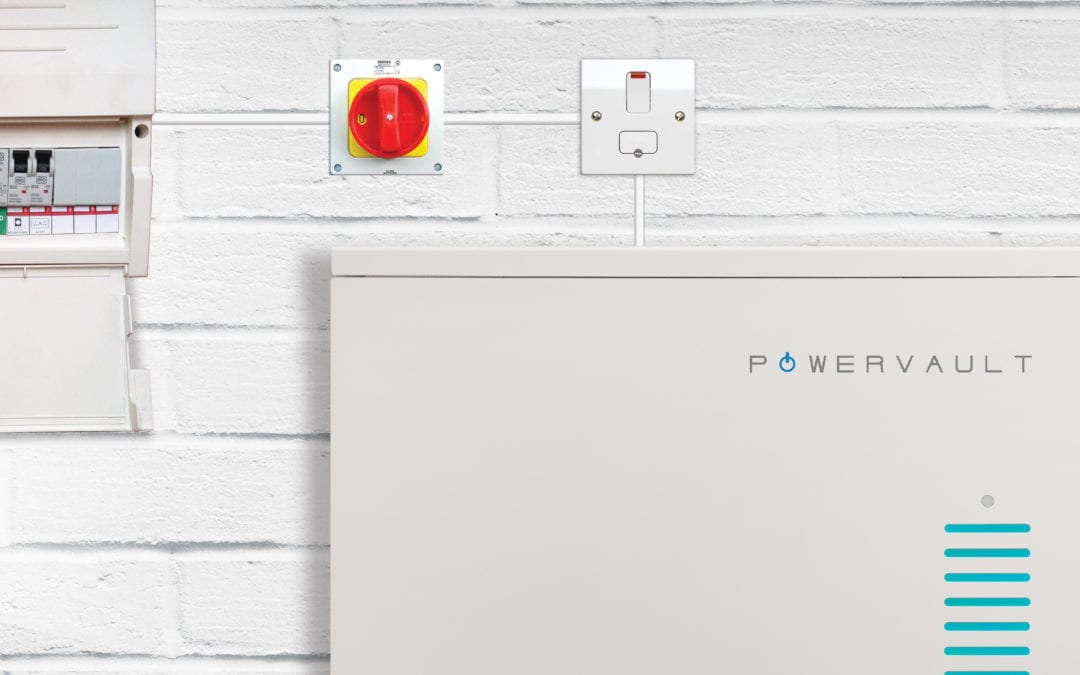
Renault and Powervault, the UK-based energy storage system manufacturer, announced a partnership to re-use electric vehicle (EV) batteries in home energy storage units. The saving to Powervault will make its storage system 30% cheaper, allowing its home storage system to become a financially viable solution to households across the UK.
Electric vehicle batteries are typically used until it depletes 20% of its capacity, after which it needs to be replaced, leaving a healthy portion of battery left for static battery applications, which are less demanding on the technology than the harsher requirements of transport applications. Typically an EVs battery can handle between 2,000 and 5,000 cycles or more depending on which supplier and what cell chemistry is used in the battery. BAIC models, for instance, using a LiFePO4 (Lithium Phosphate) based battery, guarantee 2000 cycles while the first Chevrolet Volt’s listed 5000 cycles. The Chevrolet Volt, however, electronically limits that only 65% of the battery is made available to the car to protect the battery, so to compare apples to apples, it would be better to compare throughput as appose to cycles.
Renault has already sold over 100,000 electric vehicles between its Zoe, Twizy, Kangoo and Fluence models, of which 25,000 are older than four years. Renault’s EV business model includes leasing its batteries to customers. Extending the usage of its batteries through a second-life application will provide Renault with a better return on investment and hopefully in future bring down the price of batteries faster.
According to the press release, Powervault will place 50 units on trail at existing customers who already have the company’s solar panels installed. The trial will explore the technical performance of second life batteries as well as customer reaction to home energy storage to help develop a roll-out strategy for the mass-market. The trial will be run with eligible customers of M&S Energy, plus social housing tenants and schools in the South East.
The relatively high cost of Home Storage Systems has until recently made little financial sense, with payback periods from savings overshooting the useful life of the system. Bringing system cost down to an acceptable payback of between five and seven years is seen as the holy grail for system manufacturers and homeowners.
Other EV manufacturers have already pursued business plans for second life batteries in Battery Home Systems with or without Solar. In June 2016 Nissan and Eaton installed an Energy Storage Solution in France, created from “second life” Nissan Leaf batteries. Nissan installed the Energy Storage Solution at WEBaxys, a data center. In the same month, BMW announced that it would follow Daimler, Nissan, and Tesla in creating second life energy storage systems for residential and commercial use. Second life battery systems would not have the same warranties as new systems.
Extending the life of EV batteries will also result in lower recycling related cost and overall optimize the use of the battery. Second Life applications and applications such as Vehicle-to-Grid (V2G), where an EV owner sells power back to the grid, makes electric vehicles much more appealing and blows in the face of the technologies detractors.
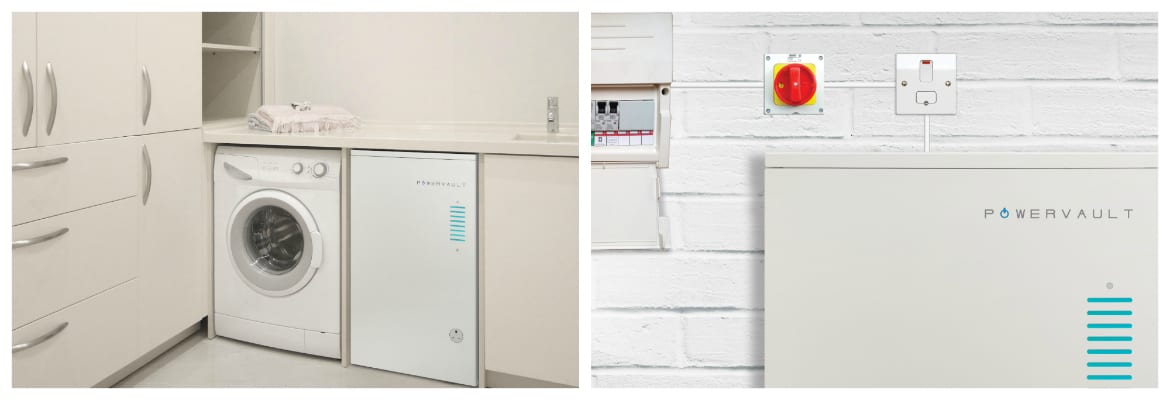
Interested in learning more about Chinese electric vehicles? Download our fun and easy app below, flick the switch to your preferred option and swipe left the models you don’t like, right the ones you do, enter the chat rooms and share your thoughts with the community.
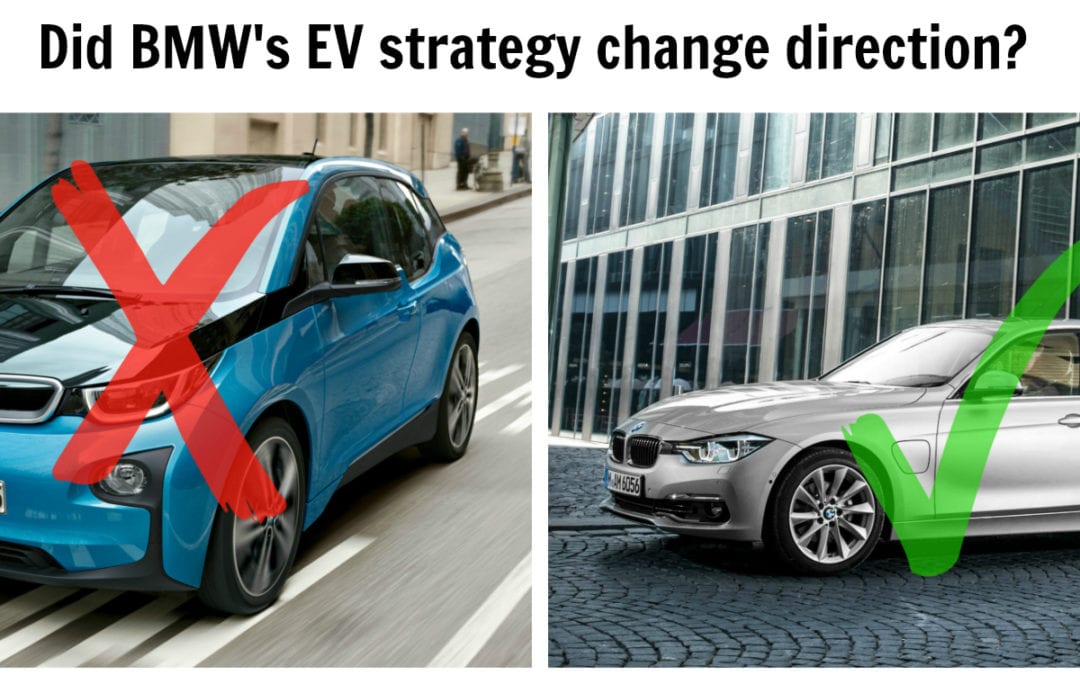
Reports this week hinted that cost issues are driving BMW to depart from its dedicated EV brand strategy. BMW CEO, Harald Krueger last year set the German automaker’s strategy as follows:
“Our Strategy Number One Next is centred on consequent lightweight construction, alternative drivetrain technology, connectivity, autonomous driving functions and the interior of the future. The iNext will set the standard from 2021″
Only three weeks ago wattEV2Buy reported that the BMW AGM determined that it would start producing it iNext autonomous brand at its Dingolfing plant form 2021.
Unconfirmed online reports this week claimed that BMW would not pursue the development of the BMW i5 as its mass market answer to the Tesla Model 3, but rather follow other carmakers such as Hyundai and Citroën, by offering electric options across existing ranges so that customers can choose a gasoline model or an electric model.
The reason for the change of heart is that the cost associated with the specialized chassis systems of the i8 and i3 makes it unsuitable for high volume production. In March BMW’s reported its lowest profitability since 2010 on the back of spending on technologies to compete with its rivals in the electrification and autonomous sectors.
It seems BMW is struggling to communicate or find a definitive answer to present as its mass market EV solution. In March of 2017, the BMW CEO hinted that the Mini could be automakers mass market EV.
The following statement by Harald Kreuger this week, “The all-electric MINI and the all-electric BMW X3 will mark the beginning of the second wave of electrification for the BMW Group, benefiting from the ongoing technological progress we are making in this area.” is seen to support the reports that the company is having a rethink on its EV Next strategy.
BMW’s change of direction will set it on a different course than its competitor in the luxury car market, Daimler, which has set an aggressive strategy to develop a separate brand to establish a market lead in the e-mobility sector.
The BMW strategy now seems to focus on finding the least cost route of adding batteries to existing models to produce vehicles for consumer’s increasing appetite for electric cars. Adding batteries to combustion vehicles is seen as a cop-out as consumers will be better served by buying electric vehicles built from the ground up around the technology.
Indian based Mahindra and Mahindra this week shed some more clarity on how it aims to compete in the electric vehicle sector. The company announced that it would construct a battery plant in Chakan, Pune City in Maharashtra State which will increase the company’s battery output ten fold. Currently, the company produces only around 500 battery packs a month for its e2O, and eVerito models from imported cells at its Bengaluru plant, the Chakan plant has a target of 5,000 units a month. The Indian company is also developing a high powered electric vehicle platform available by 2019 that is capable of speeds up to 200km/h / 125mph and a range of 350 – 400km (250 miles). The Indian government has set a lofty goal of 100% electrification of the countries vehicle fleet by 2030, but to date, the technology has failed to get any traction that can compare with its peer, China.
US-based research firm Research and Markets this week released a report indicating that they see the EV charging infrastructure market should be valued at around $45 billion by 2025. A rush by governments to encourage the adoption of electric vehicles is seen as the main driver for the uptake of the technology. The research firm also reported on the adoption trends within the charging technology sector, stating that the CHAdeMO connectors would be replaced by Combined Charging System (CCS) as the preferred connector type. The fast charger segment is said to lead over slow or home-based chargers, showing an estimated CAGR of 47.9% from 2017 to 2025.
Research firm Bloomberg New Energy Finance (BNEF) this week reported that it expects EVs to reach price parity with internal combustion vehicles (ICE) in the USA and Europe by 2025. Falling battery prices driving down cost is seen as the main reason behind the conclusion. Currently, battery prices constitute around 50% of an EVs cost, by 2020 BNEF forecast batteries to only constitute between 23% and 16% of an electric car’s total cost by 2030. The report did not compare the total cost of ownership, which is expected to favor EVs this decade already. It is unclear if the study did take into consideration regional factors such as the EU adding as much as $340 per engine on diesel engines from 2020, which should increase the cost of combustion engines.
In March the UK based Detroit Electric signed a joint venture agreement with Shanghai-listed Far East Smarter Energy Group (Smarter Energy). The JV called for the Chinese partner to invest $370 million over a four-year period. Already the JV is experiencing stress as Smarter Energy this week announced that it would transfer 40% in Detroit Electric to Far East Holding Group (Holding) to secure financing. The transaction was done at no value. Smarter Energy revealed that the financing round is taking longer than anticipated and that it is struggling to secure the required production certificates from the Chinese Government to be allowed to produce electric vehicles. Up till May 2017, only fourteen such permits have been granted by the Chinese authorities. The remaining shareholding structure of the joint venture now has Detroit Electric owning 50% while Yixing Environmental Protection Science and Technology Industrial Park 10%. It is unclear how the restructuring will impact on the company’s timeline to bring the SP:01 to production by 2018.
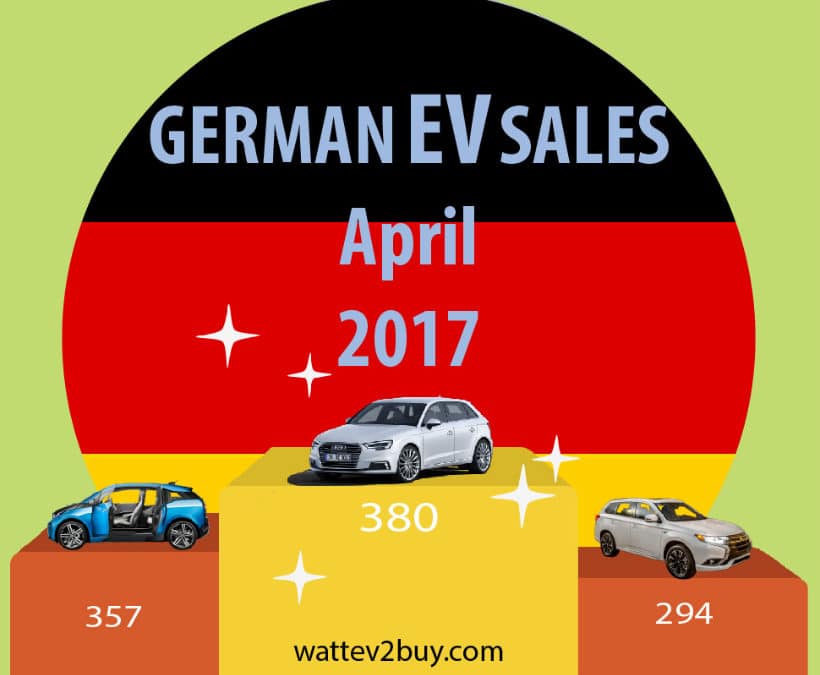
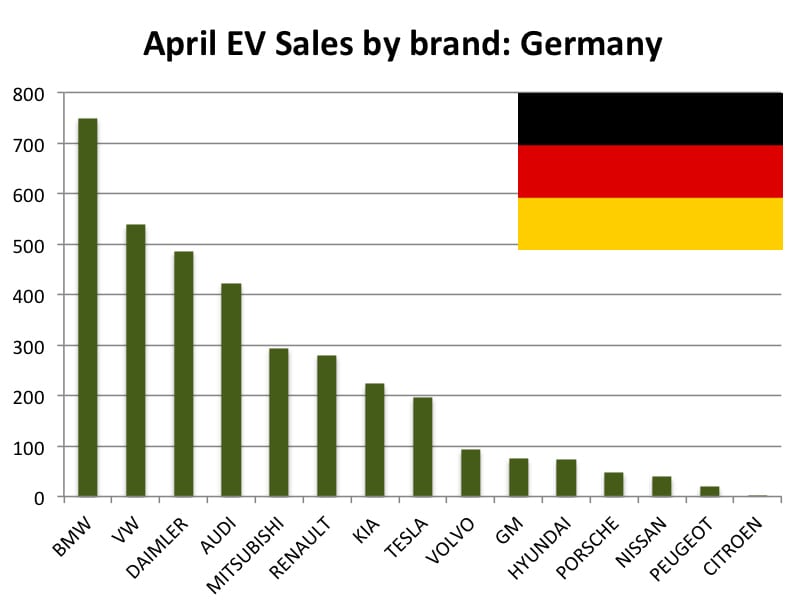
The pace of German electric vehicle sales just keeps on accelerating as the country’s April EV sales jumped 119% compared to the previous April, bringing the year-to-date increase to 82%, up from 77% in March. Battery Electric Vehicles (BEV) maintained a slight lead over Plug-in Hybrid Electric Vehicles (PHEV) with 6,843 units sold vs. 6,728. Plug-in Hybrids were, however, the leading technology for the month of April with 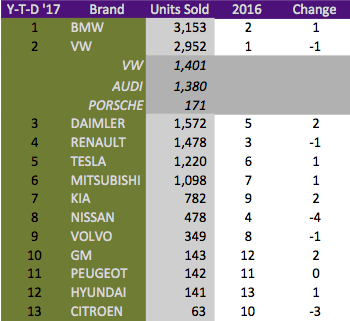 1,953 units sold vs. 1,587.
1,953 units sold vs. 1,587.
The Top EV brand in Germany is BMW, taking the crown from VW. The BMW i3, which kept on to its second position overall and the BMW 225xe Active Tourer accounted for nearly 80% of the German automaker’s total sales. Significant of the BMW i3 sales is that the consumer is shifting away from the i3 REx range extended PHEV, last years preferred variant, to the pure electric version. The ratio in 2016 was 474 i3 REx to 216 i3 BEV vs. 897 BEV to 551 REx now. The shift towards the pure electric version is an indication that consumers are getting more comfortable with the technology and that range anxiety is becoming less of a deterrent. Surprising is that Nissan lost a lot of ground in Germany, this was due to the fall in Nissan Leaf sales. The popular, yet dated Leaf, has been able to hold its commanding position in most other markets, so we have to ask the question if Germany is a sign of what’s to come. Nissan teased some pictures of the new Leaf, expected in 2018 this week. The VW brand was one of the other losers for the year-to-date, mostly due to falling Volkswagen Golf GTE and e-Golf sales. The new Renault Zoe Z.E. 40 was the most popular car in February and March but lost ground in April to the BMW i3, Audi A3, and Mitsubishi Outlander.
Smaller and cheaper models remained the top performers in Germany, but new models such as the Opel Ampera-e (rebadged Chevrolet Bolt), Hyundai Ionic and Mini Countryman SE ALL4 has yet to perform. In the luxury segment, Mercedes-Benz outsold Volvo, BMW, and Audi. Tesla remained the best performer in the luxury segment, maintaining its position, owning 10% of the total electric vehicle market in the country. The Toyota Prius, a top performer over the last couple of months in the USA and Japanese markets, is not yet available in the German market and it is unclear if it will be available here.
At this rate, Germany is expected to surpass its 2016 record with about four months to spare, a great achievement for the electric vehicle sector, boding well for global EV sales in 2017.
Please feel free to use the comment section below to share your thoughts on the German EV market and available models.
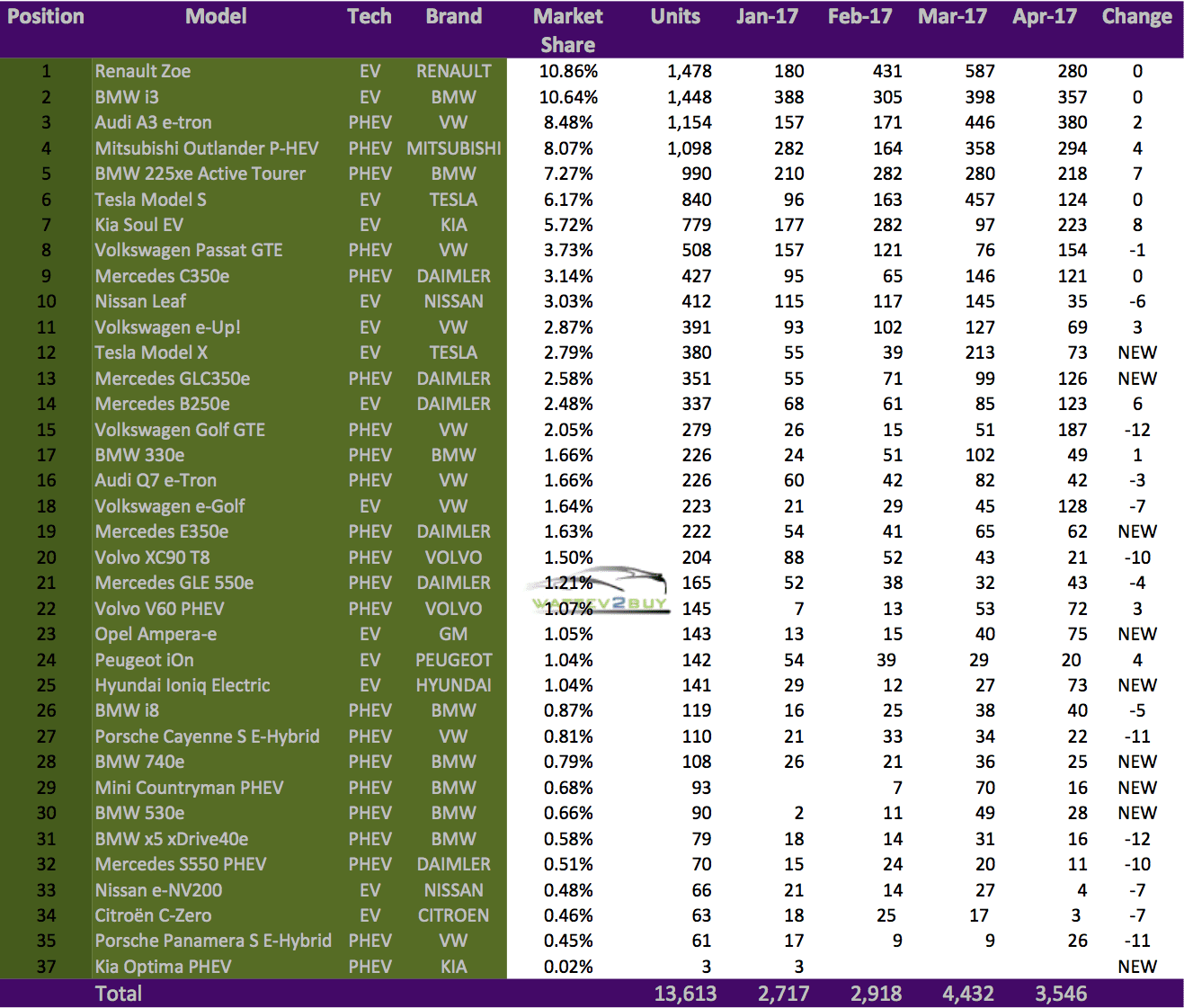
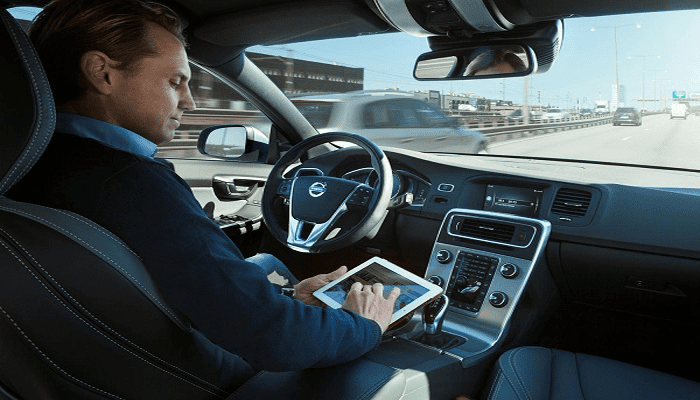
A slew of self-driving pilot programs has been announced recently, the latest being Delphi. The auto parts company previously owned by GM announced that it would roll out self-driving taxis in the USA this year. Delphi is already piloting a program in Singapore where it pilots an Audi SQ5, kitted with 26 sensors. The pilot would be extended to three vehicles in June and is done in conjunction with the Singapore government where the company hopes to have operating taxi service within three years. According to Automotive News it is anticipated that Delphi will host the US pilot in either Pittsburg or Boston and that services would commence in September 2017.
Delphi’s pilot program allows passengers to see what the cars “brain” sees on a tablet, which it calls its “comfort cam”, soothing first-time users of the service. Already speculation is rife that Intel, which just last month paid a staggering $15 billion for Isreali autonomous tech company, Mobileye, would acquire Delphi. The three companies are already integrating their technologies to provide autonomous systems for car manufacturers, as soon as 2019.
Delphi would extend the pilot to Europe in the 3rd quarter and will switch its test vehicles to an undefined electric vehicle by 2018. The regulatory environment for public testing eased last week as Germany passed a law allowing for the public testing of autonomous vehicles.
Competitors, Lyft and Waymo also signed a partnership agreement this week. Waymo, previously know as Google’s self-driving program is already piloting Chrysler Minivans and Lexuses in Phoenix. The company last month invited people living in South East Phoenix to apply for the program, allowing the participant to hail a ride via a mobile app for local trips. Already as much as 10,000 such rides have been completed by Google staff. Waymo announced in April that it would increase its autonomous fleet from 100 to 600 Chrysler Pacifica minivans. It is no surprise that Waymo did not partner with Uber since Waymo claims that Uber stole some of its technology in an ongoing court case between the two companies. Reuters reported that according to Lyft the transaction is not exclusive, leaving the door open for other partnerships such as Lyft’s shareholder GM.
GM paid $500 million last year for a stake in the USAs number two ride-sharing company; the automaker also acquired Cruise Automation to spearhead its autonomous vehicle strategy. GM is very aggressive in the autonomous space, trying to carve out a lead to make up for ground lost to newcomers such as Tesla. GM is spending vast amounts of money to this end, for instance paying $1.1 billion to acquire its second Y Incubator company, the Italian based OSVehicle, to develop a self-driving “Vehicle-as-a -Service” (VaaS) platform. GM’s efforts are seeming to pay off as the respected research firm, Navigant, recently ranked it and Ford at the top of the self-driving leaderboard.
Companies like Delphi, Intel, and Nvidia, are hoping to sell their driverless systems to automakers in what is expected to be a market of around $100 billion within the next couple of years. BMW last week unveiled 40 BMW 7-series equipped with Intel’s driverless technology. The test, using the specially converted autonomous 7-Series is part of the German company’s project that will see 155 million test miles driven. Nvidia, an early front-runner in the self-driving tech space lat week, announced that Toyota would use its autonomous microchip built on Nvidia’s artificial intelligence platform called Drive PX. Both Daimler and Audi have already partnered with Nvidia on its Drive PX system.
Precursors to larger ride sharing and hailing services would be regulation, computing infrastructure, and connectivity. Governments would have to enact regulation to allow driverless cars while processing power and data centers need to be increased many fold to accommodate driverless technology. So also is 5G connection a requirement, daily use of an average self-driving car would be four terabytes of data.
In February we provided a summary of the disengagement reports by companies doing public testing on Californias’ roads. Only 10 of the permitted 20 companies filed reports, this number would definitely increase in 2017 judging from all the pilots announced recently. The pilot programs currently in action are mostly for level three and four autonomy and are expected to be commercially available from 2020 onwards. Even though it is expected that the Tesla 2018 models would have level five compliant hardware installed full autonomy is only expected in the latter half of the next decade.
The video by BMW below provides a short overview of the different autonomous driving levels.
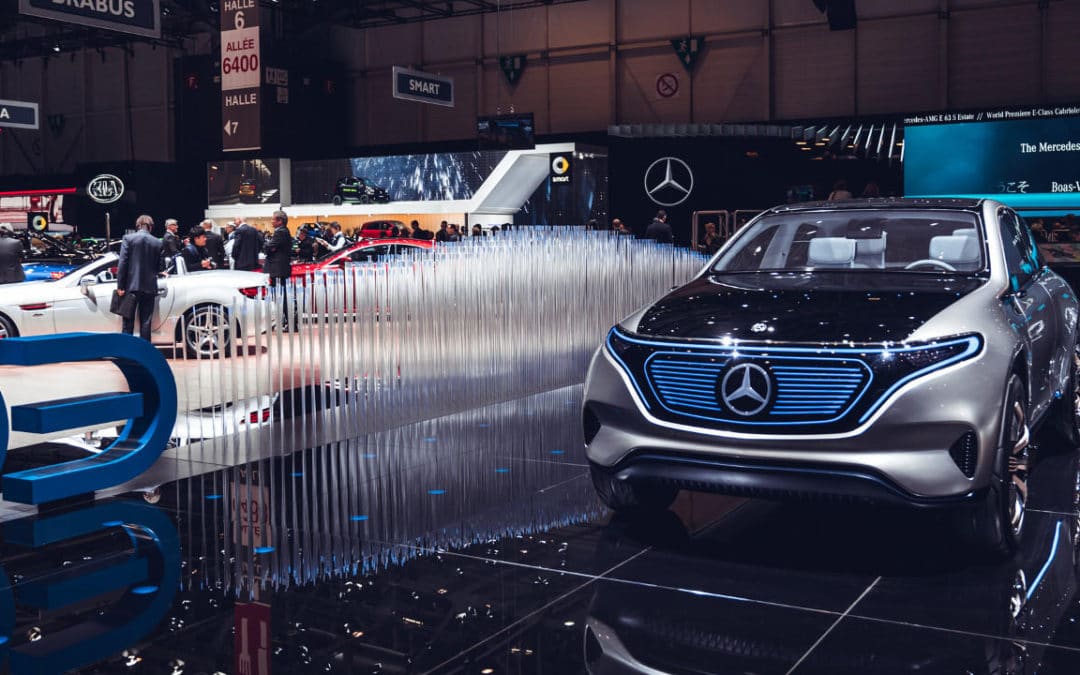
By unpacking press statements from the world’s top luxury carmakers, BMW and Daimler, over the last eight months it is clear that the Daimler EV strategy will trump that of BMW over the next decade. Up to now, BMW has led the race between the two companies in the EV sector, but the German automaker is failing to capitalize on its position. BMW was first to market with a pure electric vehicle, the BMW i3, which success even surprised itself. This week BMW released its sales data for the first quarter 2017, showing that EVs now constitute 3% of its total sales as EV sales jumped 50%. The Chairman of the Board, Mr. Harald Kruger was quoted saying “We are therefore well on course to delivering more than 100,000 electrified vehicles for the first time in 2017”. The news from the top seems very bullish on face-value but therein lies the problem. BMWs management has been flip-flopping on finding a consensus view on where they see electric vehicles in the future. This week’s news from BMW is in stark contrast from news only six months earlier when the Board grappled with if it should pursue EVs at all.
In September 2016 Reuters reported that the executive of BMW would not attend the 2016 Paris Auto Show as it grappled with its electric car strategy. At the time the company lost momentum against Mercedes and VW who is chasing Tesla. The lack of momentum caused the head of the BMW i8 project to jump ship to Future Mobility, taking most of the core team with him. The executive team remained split on the future of electric vehicles and investing in what is initially a loss making exercise. The top executive team traditionally attend the Paris Auto Show, which is one of the most prestigious events in the industry, highlighting the significance of the board’s action.
The pro-EV block prevailed but despite BMW reaffirming its strategy to pursue the development of electric vehicles the company remained downbeat on the sector. BMW’s Chief Financial Officer, Frederick Eichner, was quoted by Bloomberg saying “We’ve learned that people aren’t prepared to pay a higher price for an electric vehicle. I don’t see some kind of disruptive element coming from electric cars that would prompt sales to go up quickly in the next five to six years.” So its seems that BMW changed its wait-and-see approach to a go-it-slow approach and remained cautious when it came to investing aggressively in the new technology. Where at first the company was a leader in developing the new proprietary technology it now joined most of the other laggards in producing PHEV variants of existing models, with no clarity on when BEV models will be available and how many.
In early March 2017, Mr. Harald Krüger was quoted by Reuters as saying “The fully electric drivetrain will be integrated into our core brands. To achieve this, we are now gearing our architectures toward combustion engines and pure battery electric drivetrains,” as the company plans to include EV manufacturing in its mass production line. Currently, the company’s electric vehicles are assembled at its low-volume plant in Leipzig. BMW will also expand the capacity of its PHEV drivetrain plant in Thailand and fund the cost of the investment in its electric vehicle infrastructure through a production increase in its profitable SUV segment. To ramp up production to meet expected demand for the new Mini Countryman PHEV the company is considering manufacturing facilities for the Mini in Germany, the Netherlands, and the UK. The company also announced that it would start producing its iNext autonomous brand at its Dingolfing plant form 2021. Other models expected from the German automaker is the i8 Roadster PHEV (2018), a BEV Mini (2019), and a BEV X3 (2020). BMW‘s long-term electric vehicle strategy is to have EV’s contribute to between 15% and 25% of its sales by 2025.
Daimler, on the other hand, had the foresight at the start of the cycle to be an early investor in Tesla. The company invested $50 million in the Series E round in May 2009, and have been hailed by Elon Musk for saving the company from bankruptcy in the early years. Unfortunately, Daimler failed to follow the same daring approach it invested in in its own business model and fell behind BMW and Tesla.
Daimler’s passive stance changed in July 2016 when its CEO, Dieter Zetsche acknowledged the technology’s importance and expected an increase in EVs market share of the total vehicle market. The German automaker shifted its strategy to accelerate its efforts to stay abreast of its competitors, Tesla and BMW‘s push to ramp up production in the luxury electric vehicle segment. Within a short space of time, the company announced a massive $11Bln investment to support its electric vehicle strategy up to 2025, unveiled its new all-electric car brand, the EQ (Electric Intelligence) and unveiled a fully electric semi-truck. The EQ brand will develop a host of EV related services and products, not just cars, such as charging stations and battery packs. The first vehicle to come from the brand is targeted at the highly popular SUV segment, a clever move to differentiate the brand in this hotly contested sector. The EQ SUV is said to have a battery capacity of 70kWh providing a range of over 250miles powering two electric motors providing 300kW of power. The production version is expected to be launched in 2018.
In early April 2017 Daimler announced that it would accelerate its $11 billion investment in electric vehicles by bringing it forward with three years from 2025, to 2022. Reuters reported that the automaker’s aggressive stance are the result of it not being able to cut fleet emissions of 123gm CO2/km from 2015 to 2016 in Europe. Europe has set a very stringent target of 95gm CO2/km by 2020. Daimler’s own target for 2020 is 100gm CO2. The German automaker cites the popularity of SUV’s as the reason for it not cutting its emissions for the first time since 2007. Daimler’s success in the SUV segment helped it to regain its dominance over archrival BMW for the first time since 2005.
In May 2017 Automotive News interviewed Mercedes-Benz head of production and supply chain management, Markus Schaefer. When asked how the company is preparing to assemble the EQ brand Mr. Schaefer responded – “We believe the EQ family will represent 15 to 25 percent of our sales in 2025, but at the end of the day, no one can say with certainty how high the share will be. Therefore, we need maximum flexibility, meaning we will integrate the EQ models into the same assembly line as the combustion engine models they will potentially replace. Preparations are on schedule, so our plants should be capable of operating at stable output levels whatever the EV take rates may be. But in order to facilitate this greater flexibility, we also had to adapt our manufacturing.” The capacity to mass produce EVs efficiently through the full-flex plant manufacturing strategy is set to help the company recover the massive investment it will make to get ahead in the EV sector.
Daimler is also investing heavily in charging infrastructure in Europe to facilitate the adoption of electric vehicles. The final proof of Daimler’s strategy will be the early release of a full electric SUV. 2018 is certainly going to be an exciting year for the electric vehicle market.
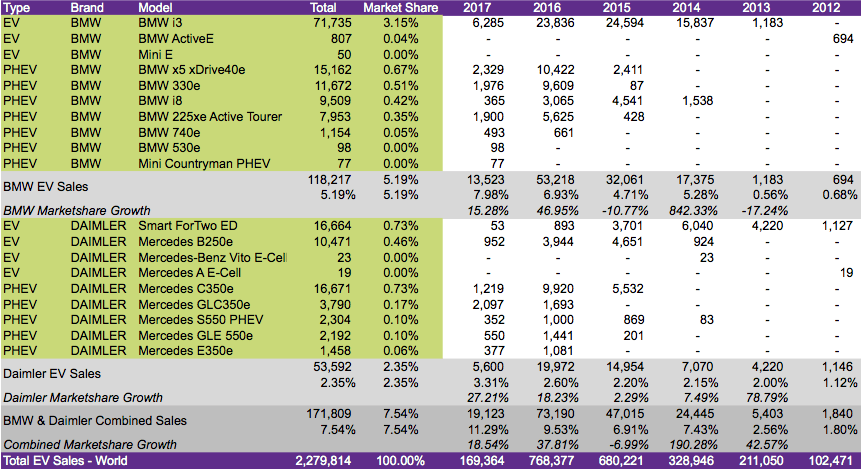
Note to data: The BMW i3 is listed as a BEV but includes sales for the BMW i3REx, a range-extended vehicle, a PHEV.
Interested in learning more about electric vehicles? Download our fun and easy app below, set your daily commute distance and price range, swipe left the models you don’t like, right the ones you do, enter the chat rooms and share your thoughts with the community.
The page you requested could not be found. Try refining your search, or use the navigation above to locate the post.

The Chinese Government released its long-term development plan for the automotive sector on the 25th of April 2017, setting out the China EV strategy. The plan, presented by the Ministries of Science and Technology and Ministry of Industry and Information Technology in conjunction with National Development and Reform Commission, sets out how the country will ramp up the local EV sector and dominate the world market.
If successful the Chinese auto sector can leapfrog the dominance of the big auto companies, such as Toyota, VW, BMW, Daimler, Ford, and GM. Big Auto has missed the boat on electric vehicles and therefore continue to downplay the technology as only a niche sector. Management boards of big auto companies are flip-flopping strategy as they try and come to grips with how to enter the market and to what extent they should invest in research in technology. BMW last week announced that EVs constituted 3% of its total sales for the first quarter of 2017 after a jump in EV sales of 50% (Top 5 EV News Week 18). With the release of the data, the company set out how it will introduce more models. The news from BMW is in stark contrast from news only six months earlier when the Board grappled with if it should pursue EVs at all (Top 5 EV News Week 49  2016). In the USA we have recently seen how newcomer Tesla is valued above Ford and GM by investors. The response by Big Auto and other detractors of EVs was that this is a temporary phenomenon, arguing that Tesla hardly produces one tenth of the vehicles any of the top brands does. If one look at total sales of Battery Electric Vehicles (BEVs), it seems investors on the other hand value companies on their future ability to produce electric vehicles. If the same apply for Chinese brands, we can very quickly expect a Chinese brand to ascend the list of top auto brands.
2016). In the USA we have recently seen how newcomer Tesla is valued above Ford and GM by investors. The response by Big Auto and other detractors of EVs was that this is a temporary phenomenon, arguing that Tesla hardly produces one tenth of the vehicles any of the top brands does. If one look at total sales of Battery Electric Vehicles (BEVs), it seems investors on the other hand value companies on their future ability to produce electric vehicles. If the same apply for Chinese brands, we can very quickly expect a Chinese brand to ascend the list of top auto brands.
According to the plan by the Chinese Government, it set a short-term target of EV sales of 2 million units locally by 2020 and at the same time elevate Chinese auto brands to be seen amongst the top ten electric vehicle brands globally. The medium term target is that EVs contribute 20% of the total annual fleet by 2025, which is a huge amount of cars. Measuring the movement in sales by brand in the table below we can already see the top Chinese EV brands, BAIC, SAIC, Geely Zhidou and JMC moving higher and two brands, BAIC and BYD in the top ten list for the first quarter 2017. Other evidence of Chinese companies investing heavily in the sector includes Chinese IT company, Tencent acquiring a significant stake in Tesla, sparking a rally in the stock.

Measures by the Chinese Government to achieve the targets above include:
China already has experience of setting itself to dominate a sector and achieving set goals. Less than a decade ago the Chinese Government plotted to dominate the PV panel market and in the process brought down the price of energy production from renewables, killing some western PV manufacturers in coal plants in the process. Already we are seeing a deluge of battery cell plants being planned by the end of the decade in China. We can, therefore, expect the same domino effect as in the energy markets, taking out auto manufacturers that were slow to embrace electric vehicles.
Interested in learning more about Chinese electric vehicles? Download our fun and easy app below, flick the China switch and swipe left the models you don’t like, right the ones you do, enter the chat rooms and share your thoughts with the community.

#1 – USA April EV Sales continue upward trend
USA EV sales for April were released this week showed an increase of nearly 25% on a year-on-year basis, bringing the 2017 figure to 54,000 units for the year-to-date, which is 41% ahead of the 38,000 for the same period in 2016.
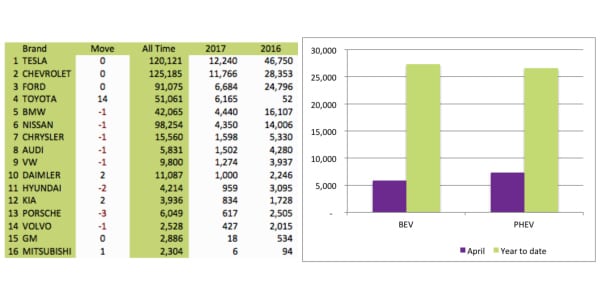
PHEV vehicles are gaining on the lead of BEV vehicles as Toyota Prius sales continued its upward momentum while deliveries for the Nissan Leaf and Tesla’s Models S and X slipped (hard). Sales for new models introduced through the month were a mixed bag, with the Cadillac CT6 PHV only racking up 6 units while the Chrysler Pacifica PHEV mustered 205 units after a delayed start to the year. The Chevrolet Bolt recovered nicely and Fiat had a record month with the 500e after introducing special deals. A big loser was the Mercedes C350e, dropping to only three units from a high of 210 in January.

#2 – Citroën’s EV strategy unwrapped
Citroën this week shed some light on its electric vehicle strategy. The PSA Group company plans EVs across the range starting 2020. The strategy mimics Hyundai’s strategy with the Ioniq, having an ICE, PHEV and BEV version. The approach is seen as quite expensive, but hopefully, the company gained some inside knowledge from the Citroen C-Zero, one of the first EVs of the decade.
Citroen CEO Linda Jackson was quoted by Automotive News Europe as follows – “Our strategy for electric vehicles is not to have a vehicle dedicated to electric, but to have electric across the range so that customers can choose a gasoline model or an electric model.”
Another PSA group company, DS Automobiles the luxury marque for the French automaker, this week announced that it would have an EV by 2019.
#3 – Tesla’s shares retreats after hitting our target
Tesla shares early in the week hit the target of $320 we predicted on the 3rd of April after which it came back to test the breakout when the company announced a loss of $322m for the quarter despite more than doubling revenues. Interestingly enough if you list GM, Tesla and Ford’s market cap and total units sold it seems that investors are valuing the three top brands in the USA on their EV unit sales only.
We picked up in the fine print of the release that Tesla will add a 100 retail, delivery and service locations during 2017 globally, representing a 30% increase. The company will also add 100 Tesla Ranger mobile repair trucks during the second quarter. The production of 5,000 Model 3s per week is still on track to commence in July.
#4 – California taxes ZEV owners
The California legislature this week passed a bill to increase revenues from the transport sector in a bid to cover the increased cost of maintaining road infrastructure. The Bill included an annual levy of $100 on ZEV vehicles to compensate for the fact that EV taxes can’t be recovered at the pump. Diesel and gasoline prices increased by $0.36 and $0.30 per gallon. California is home to nearly half of all EVs in the USA.
In other regulatory news this week impacting on EV growth the EU approved a joint venture between BMW, Ford, Daimler, and VW to develop a fast charging network in across the union. The companies will hold equal shares in the JV.
#5 – EVs now 3% of BMWs sales
BMW this week released its sales data for the first quarter 2017, showing that EVs now constitute 3% of its total sales as EV sales jumped 50%. The Chairman of the Board, Mr. Harald Kruger was quoted saying “We are therefore well on course to delivering more than 100,000 electrified vehicles for the first time in 2017”. The company also announced that it would start producing it iNext autonomous brand at its Dingolfing plant form 2021. Other models expected from the German automaker is the i8 Roadster PHEV (2018), a BEV Mini (2019), and a BEV X3 (2020). The news from BMW is in stark contrast from news only six months earlier when the Board grappled with if it should pursue EVs at all (Top 5 EV News Week 49 2016).
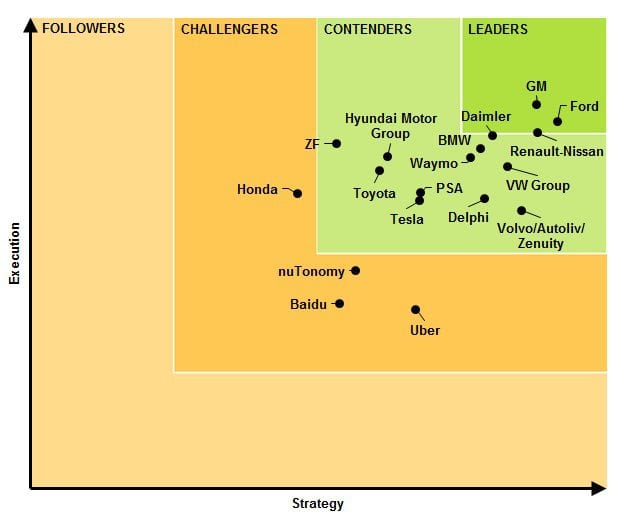
Navigant Research placed Ford and GM at the top of its autonomous driving leaderboard, surprisingly far above Waymo (7th), the pioneer of autonomous driving. Waymo was only listed as a contender, and Tesla who has already clocked over 300 million miles in Autopilot (Level 2 Autonomy) did not make the Top 10 list. Waymo, not aiming to develop a car, but rather focusing on autonomous technology has partnered with Chrysler and Ford on testing autonomous technology.Making Navigant’s findings even more surprising to us is that
Making Navigant’s findings even more surprising to us is that Waymo performed exceptionally well compared to other automakers on the list when comparing across all permit holders allowed to test autonomous tech on Californias public roads. According to CA DMV regulations, each permit holder must annually file a disengagement report, reflecting the number of events where a driver essentially has to take over from the vehicle’s autonomous mode to either prevent a traffic incident or where the system fails. Waymo posted a record 0.2 disengagements per 1,000 miles in its 2016. For a breakdown of each permit holders testing in California read our recent blog providing detailed analysis. The table below shows a summary of all the permit holders in the CA DMV program’s disengagements per 1,000 miles.

Despite Tesla aiming to have a market ready Level 5 autonomous product by the end of the year, it is only listed as a contender. Tesla is criticized by some, for being too aggressive, using its customers as guinea pigs for its AutoPilot software.
Not surprising though is that Uber features on the bottom end of the list, the controversial ride-hailing company has been in the news lately for losing its right to test in San Francisco, being sued by Waymo and a crash in Tempe, Arizona, temporarily halting its pilot program.
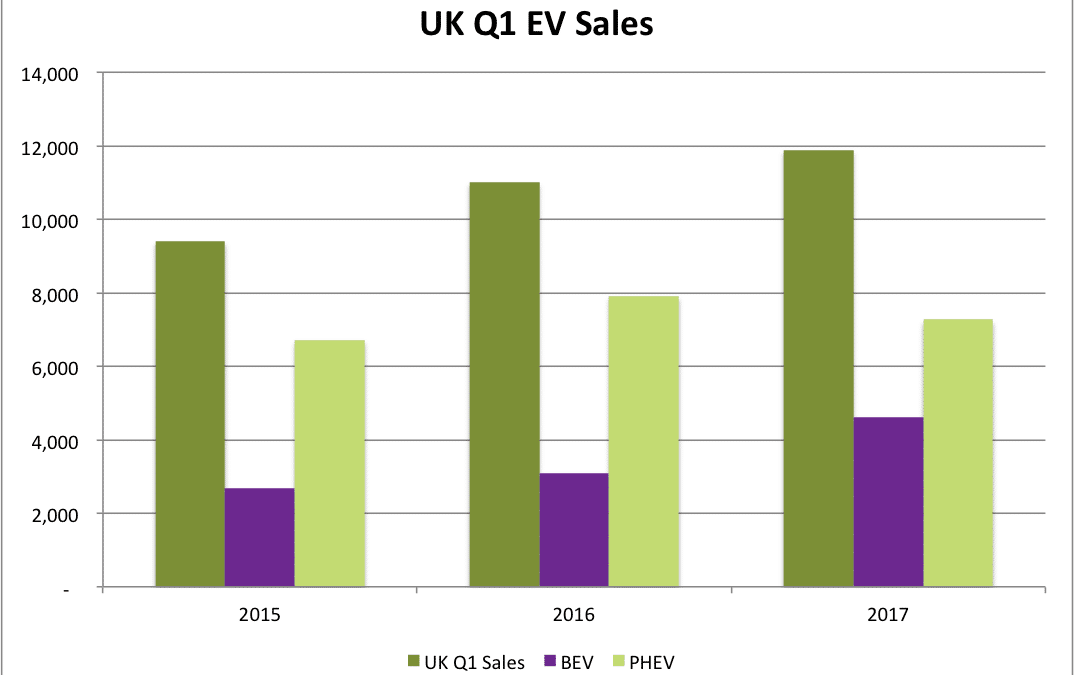
TOP 5 EV NEWS #1 – UK EV SALES Q1 2017 BREAKS RECORDS
UK EV sales for the first quarter 2017 set new records, mostly on the back of Tesla sales. The quarter’s sales bring EV’s contribution up to 1.4% of the total vehicle fleet. The UK sales for Q1, traditionally the best performing quarter for UK car sales, was closely watched as a new Vehicle Excise Duty (VED) comes into play from the first of April 2017. The new VED rules apply for all vehicles except zero emission vehicles (ZEV). According to the VED, Internal Combustion Engine vehicles (ICE) will be liable for a levy of £1,550 spread over five years on all vehicles priced over £40,000.
Electric vehicle sales for March, which contributed nearly 70% of the quarter’s sales, rose a below average 7% on a year-to-year basis, lower than the 8.4% for the total new car market. Total EV sales for the quarter was around 11,900 units, some 880 units more than Q1 2016. A deeper analysis of the UK electric vehicle sales showed a significant rise of the Battery Electric Vehicle (BEV) component, rising 34%, or around 800 units in March from the year before. Most of the 800 units can be attributed to Tesla’s massive sales drive, which led to a record 25,000 units being sold internationally, of which nearly 900, triple February’s sales, was sold in the UK during March 2017.
The improved performance of BEV vehicles compared to Plug-In Hybrid Electric vehicles (PHEV), showing a decrease of 5% to just under 5,000 units, corrects a trend since 2016 which saw 3-in-4 electric vehicles in the UK being PHEV’s.
All indications are that UK EV sales will breach the 100,000 unit mark, shared with only 7 other countries within the next couple of months. Recent surveys in the UK showed that most vehicle buyers are negative towards diesel vehicles due to diesel gate, a spectacular own goal by big auto and that 85% of vehicle owners now consider buying an EV, subject to them overcoming these EV related misconceptions.
TOP 5 EV NEWS #2 – AUDI & PORSCHE TO CO-OPERATE ON EV PLATFORM
VW sister companies, Audi and Porsche, to accelerate their respective electric vehicle strategies, this week announced that they would jointly develop a shared electric vehicle platform allowing the automakers a faster route to electric, connected and autonomous technology. The partnership will last til 2025. The German based VW Group‘s electric vehicle strategy is built on its MEB electric platform architecture, while Porsche targets the delivery of its first electric vehicle, the Mission E by 2020 and Audi, an electric SUV based on the e-Tron Quattro by 2018. Both vehicles will have various degrees of autonomy as part of its offering.
TOP 5 EV NEWS #3 – FORD’s CHINA STRATEGY
In the same week where Ford was dethroned by GM as the USA’s number two automaker, due to Tesla taking the top spot, the company released a new electric vehicle strategy for its Chinese operations. Ford, suffering from a shareholder revolt due to its lack of a convincing electric vehicle strategy and declining sales on Thursday announced that it targets 70% contribution from EV’s of its Chinese auto sales by 2025. The first phase of the strategy will be to produce a PHEV early 2018 together with its Chinese partner, Changan, also known as Chana. The company aims to have a small electric SUV within the next 5 years, capable of a battery electric range of 280 miles / 450km. The company still lacks a proper global electric vehicle strategy and the current attempt is too little and too late.
TOP 5 EV NEWS #4 – MAHINDRA & SSANGYONG ANNOUNCE EV
The Chairman of Indian automaker Mahindra and Mahindra, Anand Mahindra announced at the Seoul Motor Show this week that Mahindra and its Korean subsidiary SsangYong aims to develop a luxury electric vehicle by 2019, targeting entry into Chinese and US markets.
TOP 5 EV NEWS #5 – NAVIGANT RESEARCH DISCOUNTS WAYMO AND TESLA AUTONOMOUS EFFORTS
Navigant Research placed Ford and GM at the top of its autonomous driving leaderboard, surprisingly far above Waymo (7th), the pioneer of autonomous driving. Waymo was only listed as a contender, and Tesla who has already clocked over 300 million miles in Autopilot (Level 2 Autonomy) did not make the Top 10 list. Waymo, not aiming to develop a car, but rather focusing on autonomous technology has partnered with Chrysler and Ford on testing autonomous technology. Making Navigant’s findings even more surprising to us is that Waymo performed exceptionally well compared to other automakers on the list when comparing across all permit holders allowed to test autonomous tech on Californias public roads. According to CA DMV regulations, each permit holder must annually file a disengagement report, reflecting the number of events where a driver essentially has to take over from the vehicle’s autonomous mode to either prevent a traffic incident or where the system fails. Waymo posted a record 0.2 disengagements per 1,000 miles in its 2016. For a breakdown of each permit holders testing in California read our recent blog providing detailed analysis.

Navigant’s criteria are based on the following ten factors; vision, go-to-market strategy, partners, production strategy, technology, sales, marketing, and distribution, product capability, product quality and reliability, product portfolio and staying power. The Top Ten on Navigant’s list are Ford, GM, Renault–Nissan Alliance, Daimler, Volkswagen Group, BMW, Waymo, Volvo/Autoliv/Zenuity, Delphi and Hyundai Motor Group.
Despite Tesla aiming to have a market ready Level 5 autonomous product by the end of the year, it is only listed as a contender. Tesla is criticized by some, for being too aggressive, using its customers as guinea pigs for its AutoPilot software. Not surprising though is that Uber features on the bottom end of the list, the controversial ride-hailing company has been in the news lately for losing its right to test in San Francisco, being sued by Waymo and a crash in Tempe, Arizona, temporarily halting its pilot program.
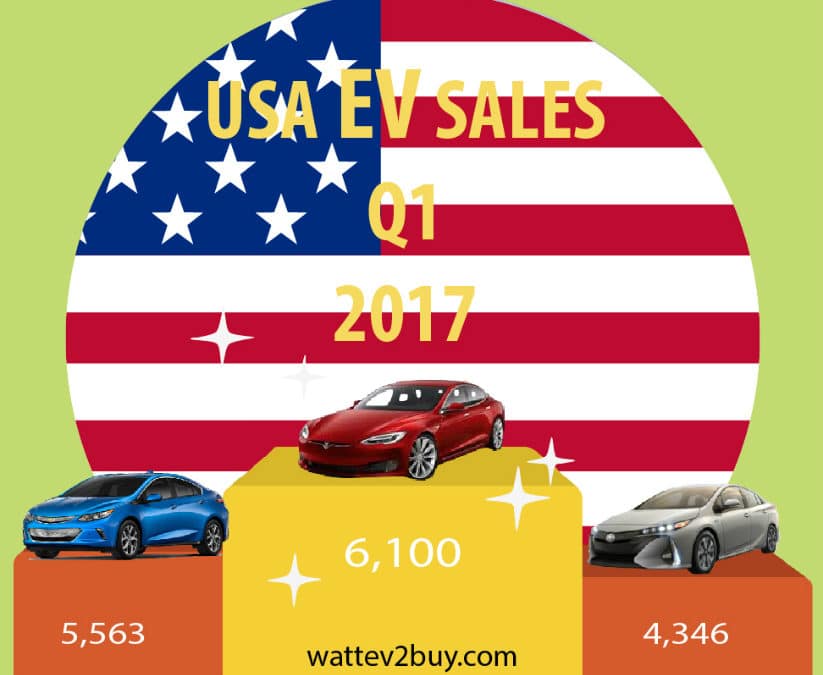
We look at the Top brands, Best and Worst Models and how the battle between battery electric (BEV) and plug-in hybrid (PHEV) technologies play out in the summary of USA EV Sales Q1 2017.
The highlights for USA electric car sales in Q1 2017 was:
There are no surprises in the Top 3 Electric Vehicle Brands as Tesla remained on top, due to increase sales of the Tesla Model X, and GM and Toyota brought new models to book. Quarter 1 2017 was the first full quarter for the Chevrolet Bolt, the world’s first mass-market car. The Chevrolet Bolt‘s performance was rather disappointing, with sales dropping from a January high. The reason can be one of two, either GM‘s slow roll-out is to blame, or most buyers are waiting for the Tesla Model 3. Toyota’s only Plug-In Hybrid (PHEV) vehicle, the Toyota Prius Premium, performed remarkably well, taking in consideration that the battery capacity and range does not offer a real advantage to its competitors.
The bad boy on the block was Ford, barely hanging on to the Top 5 list of electric cars. Were it not for Porsche’s bad performance in the VW Group; the German automaker would have unseated Ford in the Top 5. BMW dropped out of the Top 5 list as Toyota entered the list in the third position. Daimler showed commendable improvement while Hyundai and Volvo joined Ford on the losing side. Nissan still shows consistent growth with its only electric vehicle, the Nissan Leaf.
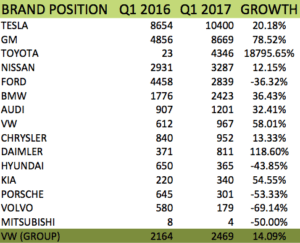
Of the new electric vehicle models that came to market in this quarter, the Toyota Prius Premium, a PHEV outperformed GM‘s Chevrolet Bolt, a BEV by nearly 30%, a disappointing performance for the first mass-market electric vehicle. Both Mercedes-Benz and BMW had two more models in this quarter compared to 2016, with the Mercedes-Benz C350e and Mercedes-Benz GLE 550e outselling the BMW 330e and BMW 740e.
The Mercedes Benz S550 PHEV, BMW i3 2017 and Tesla Model X were the best performing existing models, although for the BMW i3, its the 50% improvement in battery capacity that attributed to its increase in sales.
The Tesla Model S sales remained flat on a year-to-year basis, despite continued improvements in its software and hardware.
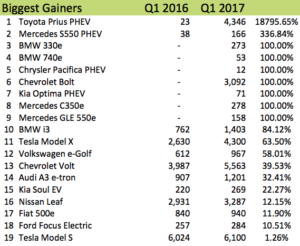
Sales of the Cadillac ELR fizzled out completely in anticipation of the release of the Cadillac CT6 PHEV this month. Both the Porsche Cayenne and Panamera showed big losses in sales from a year ago, impacting on total growth for the VW Group. Judging from the Ford models sales slump, it is clear the century-old automaker needs to reassess it electric vehicle strategy. The big drop in the Volvo XC90 T8 can be attributed to the challenge faced by all automakers coming late to the electric vehicle party. To enter the electric vehicle market, lagging brands alter existing models to include batteries but in the process lose performance as drivers complain about smaller fuel tanks.
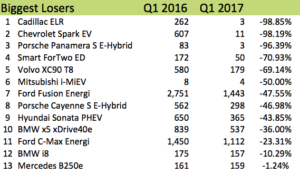
Battery Electric Vehicle’s (BEV), of which nearly half is constituted by the two Tesla models, outperformed plug-in hybrid electric vehicles. Over 20,000 BEV units were sold in the first quarter of 2017 compared to just under 15,000 a year ago. Q1 2017’s 19.2% increase in sales showed a slight improvement for the technology on Q1 2016 when BEV outsold PHEV with 17%. The USA is one of the few countries where BEV vehicles outsold PHEV’s since 2016, read our blog on the Top 10 EV Markets.
In total there is 13 BEV models and 20 PHEV models available in the USA market in 2017 so far. Consumers had a choice of seven new PHEV models in Q1 2017 and one BEV compared to the same period in 2016.
New model’s coming to market in the next quarter include three plug-in hybrids, the Cadillac CT6 PHEV, BMW 530e, and the Porsche Panamera 4 E-H, while only one BEV, the Hyundai IONIQ Electric will be released, should there be no surprises from Tesla on the Model 3.
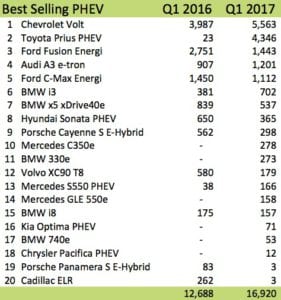
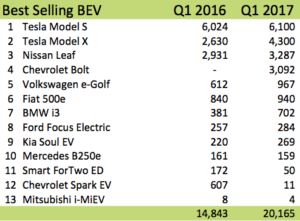
Please leave us a comment on your thoughts regarding the electric vehicle models available to the US consumer.
Note on data used: For comparison purposes, the BMW i3 sales data was assumed to be divided in two, to accommodate for the BMW i3 BEV and REx PHEV
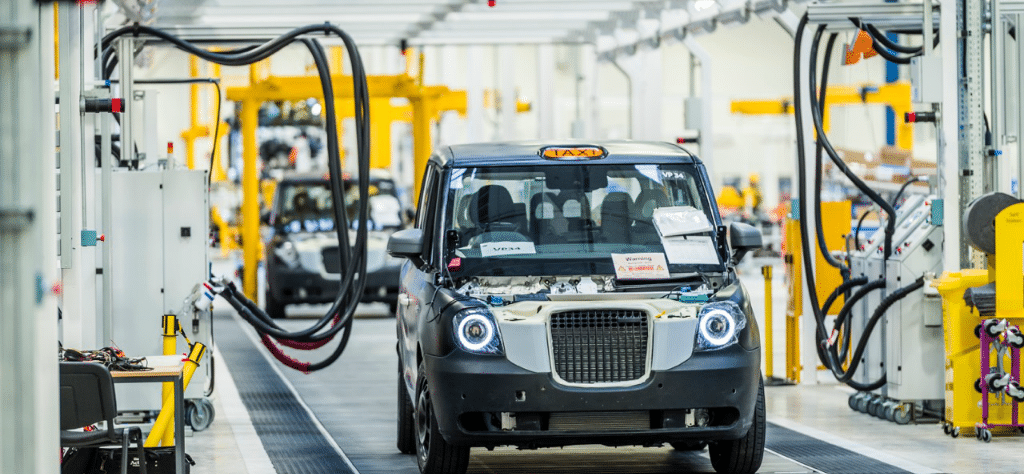
ONE
Geely’s London Taxi Company (LTC) this week opened a dedicated 20,000 unit per year electric vehicle plant in the UK, bringing Geely‘s investment in the company to £325 million. The plant located in Antsy, Coventry is the first all-new vehicle manufacturing facility constructed in the UK for the last 10-years. The investment by Geely, the second investment from China in the UK sector over the last two weeks, will create more than 1,000 jobs, of which 230 will be engineering jobs. A couple of weeks back Shanghai-listed Far East Smarter Energy Group announced an investment in UK-based Detroit Electric for the manufacturing of the SP:01 EV, creating 400 jobs.
The taxi EV to be manufactured at the plant underwent stringent testing, including being exposed to extreme weather conditions while covering over 500,000 km / 310,000 miles. The London Taxi Company‘s research and development team of around 200 people, based at Antsy, have been developing the company’s lightweight EV platform. The platform together with Volvo’s electric car powertrain provides the basis for an ultra low emission commercial vehicle. The working relationship with Volvo, another Geely-owned company, provides further technical expertise to the LTC team. The commercial launch of the taxi is in the 4th quarter 2017 for the UK market and 2018 for the international market.
London Taxi Company announced further that it would manufacturer a second vehicle at its new electric vehicle manufacturing facility. The company will produce a new range-extended Light Commercial Vehicle (LCV) EV for the international market, competing with the highly successful Renault Kangoo and Nissan e-NV200. Geely invested £30 million in research and development to bring the new LCV to market.
TWO
NextEV gets support for its autonomous car the NIO EVE. Baidu Inc, the Chinese search engine this week led an investment round estimated at $600 million into NextEV. Baidu, looking for new growth areas, created a $3 billion investment fund, Baidu Capital, found the fast-growing electric vehicle market attractive at a time when the vehicle and the internet are moving closer to each other. NextEV raised $500 million in 2016 from investors such as Tencent, who is also invested in Future Mobility, Hillhouse Capital, who also invested in UBER, Sequoia Capital and Joy Capital.
THREE
A trademark complaint in China filed by Chery Auto will hamper Mercedes-Benz new electric vehicle brand EQ‘s international aspirations. The Chery eQ, one of the most popular EV micro car’s in China over the last two years share too much similarity for the German automaker to be allowed to use the name in the worlds’ largest electric vehicle market. The Chery eQ sold around 25,000 units since it’s launch in 2015, making it one of the top 10 electric vehicles in the country. Mercedes-Benz launched the EQ brand at the Paris Auto Show in late 2016 to house all its electric vehicle products and services. One can only wonder how a large corporate could have let that one slide! The EQ brand stands for “Electric Intelligence” and is the spearhead for Daimler’s efforts to have electric vehicles represent between 15% and 25% of its global sales.
FOUR
Mahindra and Mahindra Ltd is eyeing both luxury electric vehicles comparable to Tesla under the Pininfarina brand and mass market vehicles. Mahindra’s MD, Mr. Pawan Goenka made the comments in an interview with the Indian publication Live Mint. According to Mr. Goenka, he does not foresee the Indian Government to go the subsidy route. It is, therefore, necessary for EV prices to come down between Rs40,000-50,000 (around $750) for it to make financial sense. He admitted that the company is currently losing money on EV’s but that Mahindra is in it for the long haul, and will remain committed to the sector. Mahindra is targeting the Asean (Association of Southeast Asian Nations) markets for its EV business.
FIVE
BMW is shedding some lite on its short-term electric vehicle strategy, according to Reuters, citing CEO Harald Krüger. The German automaker hinted that the Mini could be the BMW mass-market electric car, competing with the Tesla Model 3 and Chevrolet Bolt, as the company targets over 100,000 EV sales for 2017, up from 62,000 in 2016. Read our full blog on the press release here.
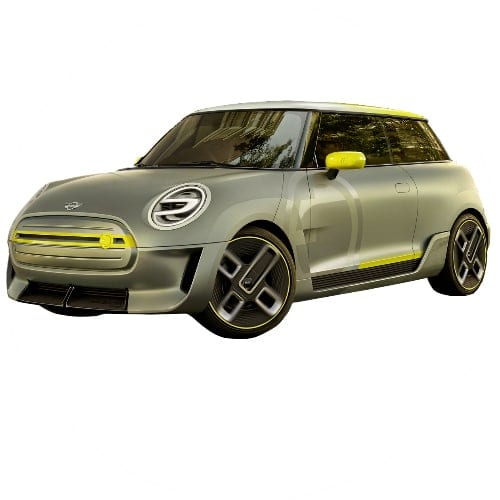
BMW is shedding some lite on its short-term electric vehicle strategy, according to Reuters, citing CEO Harald Krüger. The German automaker hinted that the Mini could be the BMW mass-market electric car, competing with the Tesla Model 3 and Chevrolet Bolt, as the company targets over 100,000 EV sales for 2017, up from 62,000 in 2016.
BMW is releasing the Mini brand’s first electric vehicle mid-2017. The Mini Cooper Countryman S E All4, available at dealers in Europe from 24 June 2017. Mini’s first attempt, the Mini E, was produced in a limited amount and only used for field trials in 2010.
Mr. Harald Krüger was quoted as saying “The fully electric drivetrain will be integrated into our core brands. To achieve this, we are now gearing our architectures toward combustion engines and pure battery electric drivetrains,” as the company plans to include EV manufacturing in its mass production line. Currently, the company’s electric vehicles are assembled at its low-volume plant in Leipzig. BMW will also expand the capacity of its PHEV drivetrain plant in Thailand and fund the cost of the investment in its electric vehicle infrastructure through a production increase in its profitable SUV segment. To ramp up production to meet expected demand the company is considering manufacturing facilities for the Mini in Germany, the Netherlands, and the UK.
BMW‘s long-term electric vehicle strategy is to have EV’s contribute to between 15% and 25% of its sales by 2025.
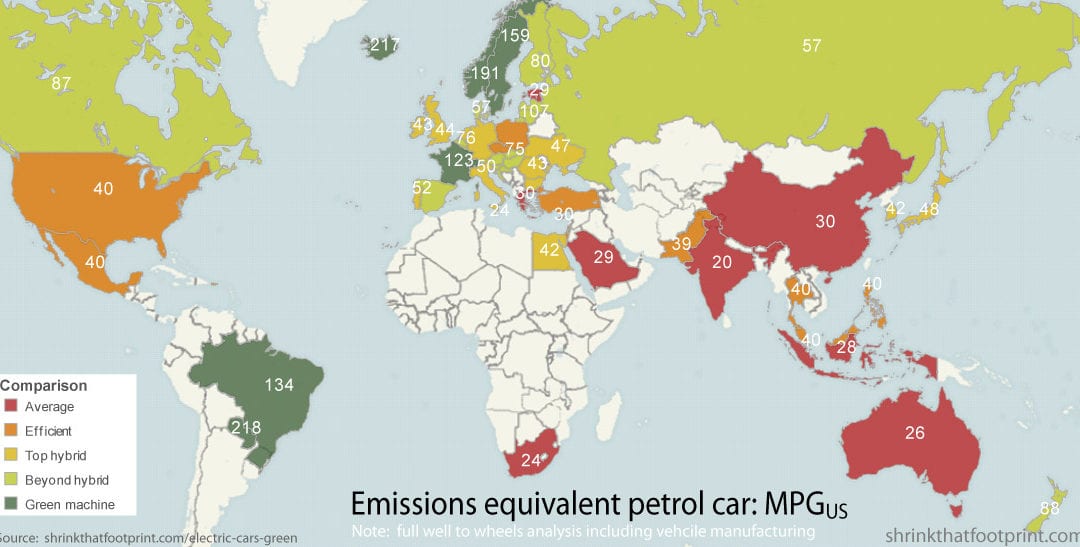
ONE
Bloomberg printed an article this week named “The Electric Car Rush Started Too Early” following BMW‘s release of its financial statements, showing a profit margin of only 8.9%, which was the lowest since 2010. The reason for the pressure on some automakers bottom line is the heavy investment required in research and development for the strategy shift towards new mobility trends, including autonomous vehicles, electric vehicles, connected (focus on secure), and shared mobility options. In BMW‘s case, the investment so far is $4.3 billion. The article also criticized EV’s real environmental cost by the hand of a graph (below) from the website shrinkthatfootprint.com showing that EV’s carbon emissions, when charged from coal, can be as much as four times higher than when charged from green sources such as hydro and other renewables.
TWO
Next EV‘s CEO announced this week that it plans to commercially launch an affordable Level 4 Autonomous electric vehicle in the USA by 2020. The model will be released under the company’s newly minted NIO brand. NIO is partnering with Israeli Mobileeye (camera-based autonomous systems), Nvidia (AI chip) and NXP semiconductors on the autonomous system.
THREE
The Mercedes parent, Daimler AG invested in ChargePoint, the operator of a network of charging stations. The investment is in line with the German automakers push into electric vehicles.
Another significant investment this week was by the Shanghai Listed Far East Smarter Energy Group in the UK based Detroit Electric. The investment totaling £1.5 billion will eventually lead to the creation of 400 jobs at the company’s Leamington Spa facility for the production of its SP:01 EV.
FOUR
Although light on new commercial electric vehicles the Geneva Motor Show this week offered some great eye candy in the form of new concept vehicles, which included:
Nissan announced the unveiling of the new version of its popular Leaf EV expected in September, with commercial sales shortly after that. The Leaf is expected to have a range of 200 miles and some autonomous driving ability through its ProPilot system.
Techrules from China unveiled their four wheels three seater production sportscar, the Techrules REn, which features range extender technology.
FIVE
On the regulatory front. In the east a ministerial meeting was called in India, chaired by the finance ministry to setting standards for the country’s electric vehicle future. In the west, the British Budget failed to give anything new to the electric vehicle sector. Some market observers expected guidance on emissions and carbon taxes. Chancellor Hammond did, however, confirm £270 for EV’s AI and robotics.
.
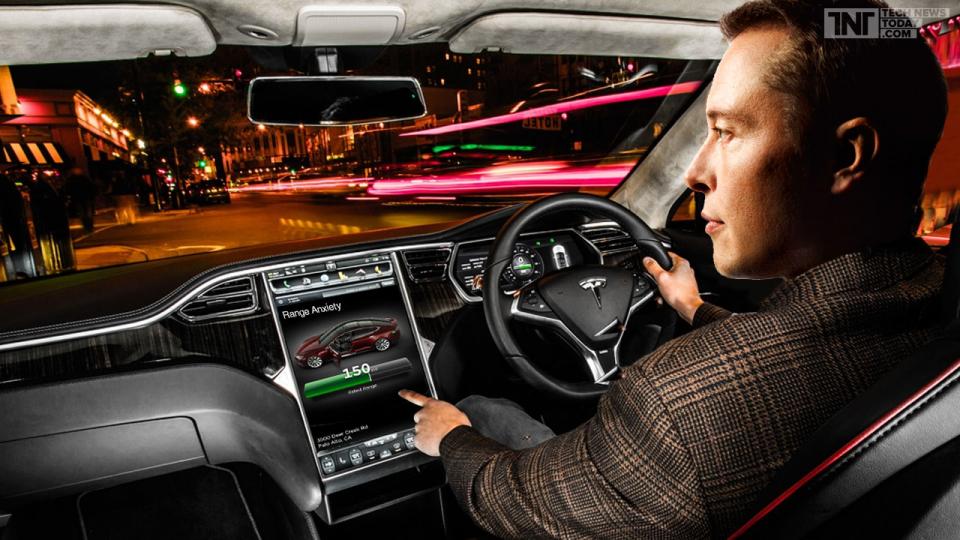
The barriers to entry into auto manufacturing became ever higher over the last 100 years before the disruption caused by technological advances in electric vehicles and self-driving technology. Most of the auto brands that were around at the turn of the century have been around for 50 years or longer; the only newcomers was a spate of Chinese brands backed by the government. For an individual to reach the top 50 position on the Forbes list from vehicle manufacturing was only possible if your parents left you a trust fund with a bunch of 100-year-old stock in a big brand. In fact, the only Forbes Top 50 billionaire from the auto sector was the German’s, Herbert and Johanna Quandt who owned nearly 50% of BMW and Georg Schaeffler (Number 39 on Forbes 2016 list) who inherited the automotive parts company, Schaeffler Group. After their passing of Johanna Quandt, the children, Susanne Klatten (Number 38) and her brother Stefan Quandt (Number 48), became the beneficiaries. Mrs. Klatten invested her fortune in pharmaceuticals, helping her to gain over her brother.
Come to the turn of the century and along came Elon Musk, risking it all on a technology that has been shunned for 100 years by big auto. Being a start-up in a market controlled by a couple of dinosaurs was not easy at first, Mr. Musk had to back himself in the first couple of rounds of fundraising for the electric vehicle company, Tesla. The table below shows that Elon Musk pretty much up until late 2008 lead fundraising and loan rounds. The risk paid off as Elon Musk became by far the richest person in the US auto sector and at the time of going to press Elon Musk jumped to the 83rd position, up from 94 in the official 2016 Forbes list of the world’s richest people.
[supsystic-tables id=105]
Other early billionaires in the technology include the savvy investor Warren Buffet and Vincent Bollore. Warren Buffet, the world’s 3rd richest individual through his Berkshire Hathaway, controlled company, Mid-American Energy Holdings in 2008 bought 10% in BYD, a Chinese battery company, now the world’s largest electric vehicle manufacturer. The Investment at the time was $230m. Berkshire Hathaway is also a significant minority shareholder in GM.
Vincent Bollore, France’s 10th-richest person with an estimated personal fortune of $6 billion dollars, started manufacturing batteries in his company Bollore Blue Solutions. The firm, situated in Brittany province, who’s batteries are cheaper than lithium-ion cells used in other electric cars, allows it to hold down the cost of his small vehicles.
Suddenly investing in electric vehicles became sexy. Chinese billionaires, mostly from the technology sector, were the first to climb into the auto sector, some more successful than others. The Chinese electric vehicle boom is fuelled by government incentives targeting that 8% of all new vehicles should be EV’s by 2018.
The tech billionaire and founder of BitAuto, an online vehicle sales platform, William Li started the Shanghai-based NextEV. The company raised $500M of an expected $1Bln already, sporting shareholders such as Tencent, who is also invested in Future Mobility, Hillhouse Capital, who also invested in UBER, Sequoia Capital and Joy Capital. The company invested C¥3Bln in Nanjing High-Performance Motor Plant to produce 280,000 electric vehicles per year. NextEv also signed a partnership with one of the largest Chinese auto companies, JAC Auto which will see them share technology, manufacturing, supply chain, marketing, and capital.
Tencent mentioned above is owned by the world’s 46th richest person, Ma Huateng of China, also know as Pony Ma. Tencent, which applications include the popular WeChat app, aims to leverage its tech experience in a world where connectivity and the Internet of Vehicles will drive the auto industry. The development of electric vehicle technology provides a perfect platform for tech and vehicles to meet. To this end, Tencent created a company Future Mobility and targeted an autonomous vehicle by 2020.
The Chinese billionaire, Jia Yueting, founder of LeEco which owns LeTV, the Netflix of China invested in two electric vehicle companies, LeEco, which developed the acclaimed LeSee concept vehicle and Faraday Future, developer of the disastrous FF91, unveiled at the 2017 CES. Both businesses are known for making bold statements and big ticket announcements just to be followed by press reports of cash flow and funding problems.
The Chinese internet giant, Alibaba, owned and founded by Jack Ma who is 33rd on the 2016 Forbes list, invested $160M in a fund where it partnered with SAIC, one of the largest Auto manufacturers in the China to develop internet connected cars. The first car to come from the partnership is the Roewe OS RX5, where OS stand for Operating System and using SAIC’s luxury brand Roewe as a platform. The software runs on Alibaba’s YunOS operating system. Jack Ma unveiled the car in July 2016. The Alibaba Connected Car will have its own Internet ID, not needing WiFi or GPS services, enabling it to connect and identify drivers  through their smartphones and wearables. The RX5 has four cameras providing it 360° vision and is voice controlled. The vehicle’s starting price is around $15,000 or C¥100,000.
through their smartphones and wearables. The RX5 has four cameras providing it 360° vision and is voice controlled. The vehicle’s starting price is around $15,000 or C¥100,000.
Alibaba beat other carmakers and tech companies to the finish line with the 2016 release of the RX5. In 2015 Toyota invested $1 billion in artificial intelligence research, while Apple invested $1 billion in Chinese ride-hailing app, Didi Chixing. BMW went into partnership with technology firms Mobileye and Intel, providing the automaker with operating systems and driving assistance software while Kia and Google partnered around the search engine’s Android Auto operating system.
Robin Li, number 90 on Forbes List and owner of Chinese search engine Baidu, partnered with chipmaker Nvidia in September 2016 to develop a computing platform for self-driving cars. Baidu recently received approval from the Californian Department of Motor Vehicles to test autonomous vehicles, in Google‘s back yard. Baidu also partnered with BMW on creating an autonomous car.
Now that the floodgates are open, billionaires from around the world are looking to enter the electric vehicle and self-driving sectors. The world’s fourth richest man, Carlos Slim of Mexico, announced this early this year that he would back the development of a Mexican-produced electric vehicle through his company, Giant Motors in a joint venture with Grupo Bimbo, the world’s largest bread maker. The strategy plays off in an environment where many US based automakers are contemplating bringing production back to the USA amidst President Trumps America First policy environment. Mr. Slim said the electric vehicle would be designed specifically for Mexican conditions.
Bloomberg reported that the JSW Group’s owner and Chairman and India’s 19th richest man, Sajjan Jindal, announced in Davos, Switzerland his intention to enter the Indian Electric Vehicle market by 2020. The metals tycoon expects the Indian government, like many other governments, will promote EVs once it’s more affordable.
It is clear that some of these businessmen are purely opportunistic, targeting to profit from regulation and subsidies for the promotion of electric vehicles.The majority, however, leverages their passions to bring better and more advanced options to the consumer at a much faster pace than what big auto ever moved in the last 50 years.
Although not mutually inclusive to electric vehicles, self-driving cars, deployable on combustion vehicles also, will drive the second phase of disruption in the auto sector over the next ten years. Self-driving car’s poster child is Google, owned by the 12th and 13th richest individuals in the world, Larry Page, and Sergey Brin. The company started testing it’s quirky autonomous vehicle as far back as 2009. Google recently spun the project into a standalone brand, named Waymo, meaning “a new way forward.” The company aims to partner with vehicle manufacturers instead of developing its own car. The first of such efforts was the conversion of 100 Chrysler Pacifica’s Plug-in Hybrid vehicles. Google, in many’s eyes, has lost the lead to Tesla, who’s progression was much faster and already has active Level 2 autonomy available in its production vehicles.
It will be interesting to compare the Forbes list of wealthy individuals ten years from now to one at the start of the century; we expect much more fresh faces who made their money from disrupting the auto sector. As a footnote, the lesson learned time and time again by dinosaurs in an industry are that they become too big, arrogant and slow, creating opportunities for new hungry entrants.
Picture: Source www.technewstoday.com
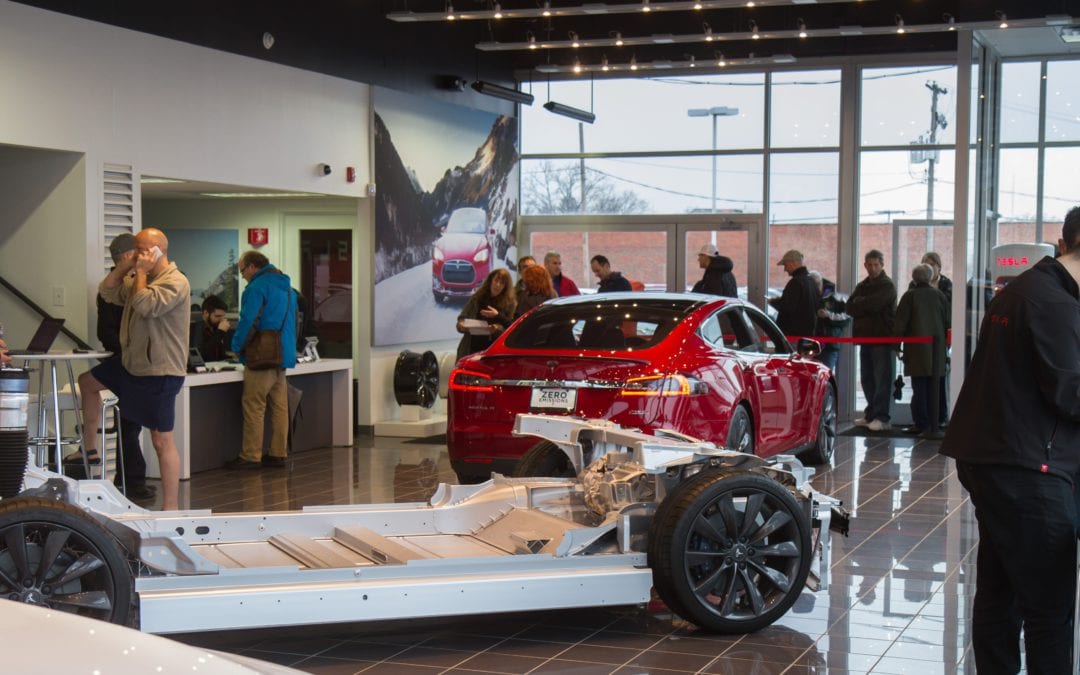
Tesla voted the consumers darling in the Consumer Reports Annual Owner Satisfaction Survey with 91% Tesla owners responded with a “Definitely yes” when asked if they will buy the brand again. Second with only 84% was Porsche. The bottom quartile included brands such as Jeep, Nissan, Fiat, and Volkswagen, which dropped eight places. The survey included over 300,000 vehicles. Can the States who is refusing Tesla’s direct selling model, naysayers, and auto dealers refusing to get behind electric vehicles please respond to this? For the complete list follow the link.
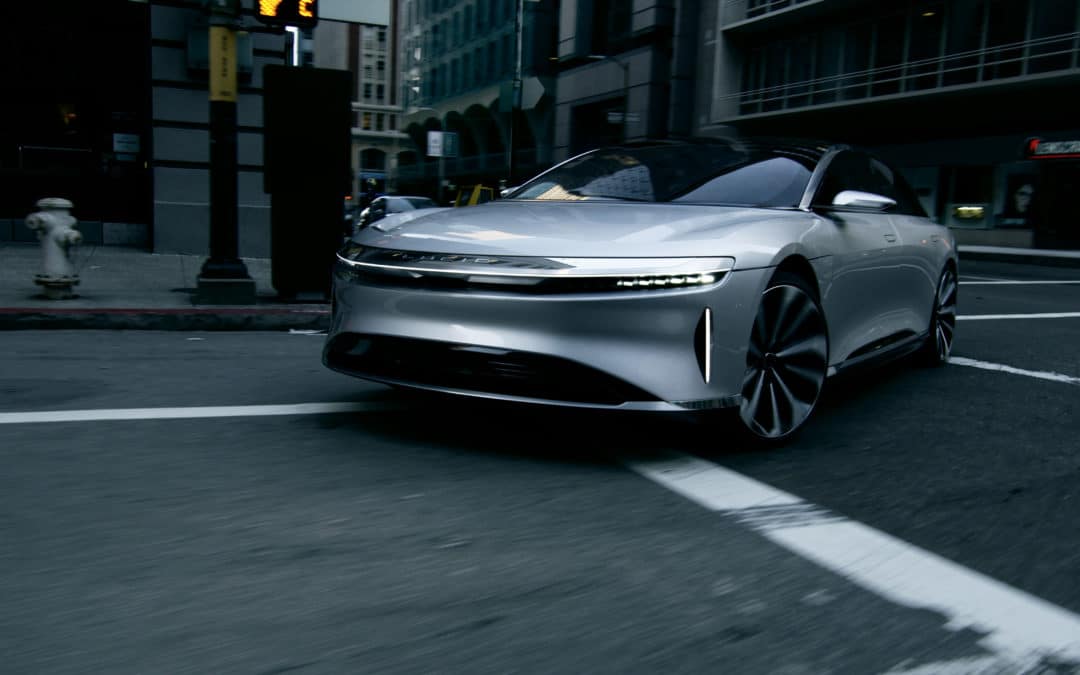
#1 – FARADAY FUTURE TEASES AHEAD OF CES 2017
Faraday Future revealed several teasers of its Electric Vehicle in anticipation of its launch during the Computer and Electronics Show in Las Vegas early next year. The teasers posted on Instagram included darkened images of the rear and front of the vehicle, leaving much to the imagination. The teasers also included video’s of the masked vehicle in motion and racing a Bentley and Tesla. The company is keeping up appearances despite recent reports that cash flow issues are hampering the construction of its Las Vegas assembly plant.
#2 – Lucid Motors partners with Samsung SDI on battery tech
Lucid Motors, the newly branded automaker from Silicon Valley, previously know as Atieva, and Samsung SDI entered into a strategic partnership on creating a next generation lithium-ion battery cell, focussing on improving the energy density and lifespan associated with damage caused by fast charging. Lucid’s Director of Battery Technology, Dr. Alber Lui said: “I have been very pleased with the results of the collaboration with Samsung SDI in developing a cell chemistry that meets our stringent standards.”
#3 – Trump appoints “Enemy of EPA” to head it
President-elect Donald Trump this week appointed Scott Pruitt as the Environmental Protection Agency’s (EPA) new head. The appointment of a self-proclaimed enemy of the agency as its head is sparking fear in environmental circles, including the electric vehicle sector. Traditional automakers have already called for changes in the agency’s emissions targets. It seems however that the agency is fighting back with it fast tracking the filing of its midterm review before President Trump’s inauguration. The new standard calls for a fuel consumption limit of 54.5 MPG by 2025.
#4 – Possible EV from Chinese smartphone maker
Chinese Smart Phone maker, Xiaomi, also know as the “Apple of China” in a surprise move announced that it would unveil an electric vehicle on Monday the 12th of December. Speculation is rife on the type of electric vehicle that the company could launch, with most commentators believing it to be a scooter or Neighbourhood Electric Vehicle (NEV). It will not be the smartphone makers first electric vehicle, earlier this year the company unveiled an electric bicycle, the Mija Qicycle, a 250watt electric motor with a range of 45km (28miles).
#5 – BMW downbeat on EVs
Despite BMW’s reaffirming its strategy to pursue the development of electric vehicles at its September board meeting, the company remains downbeat on the sector. BMW’s Chief Financial Officer, Frederick Eichner, was quoted by Bloomberg saying “We’ve learned that people aren’t prepared to pay a higher price for an electric vehicle. I don’t see some kind of disruptive element coming from electric cars that would prompt sales to go up quickly in the next five to six years.”
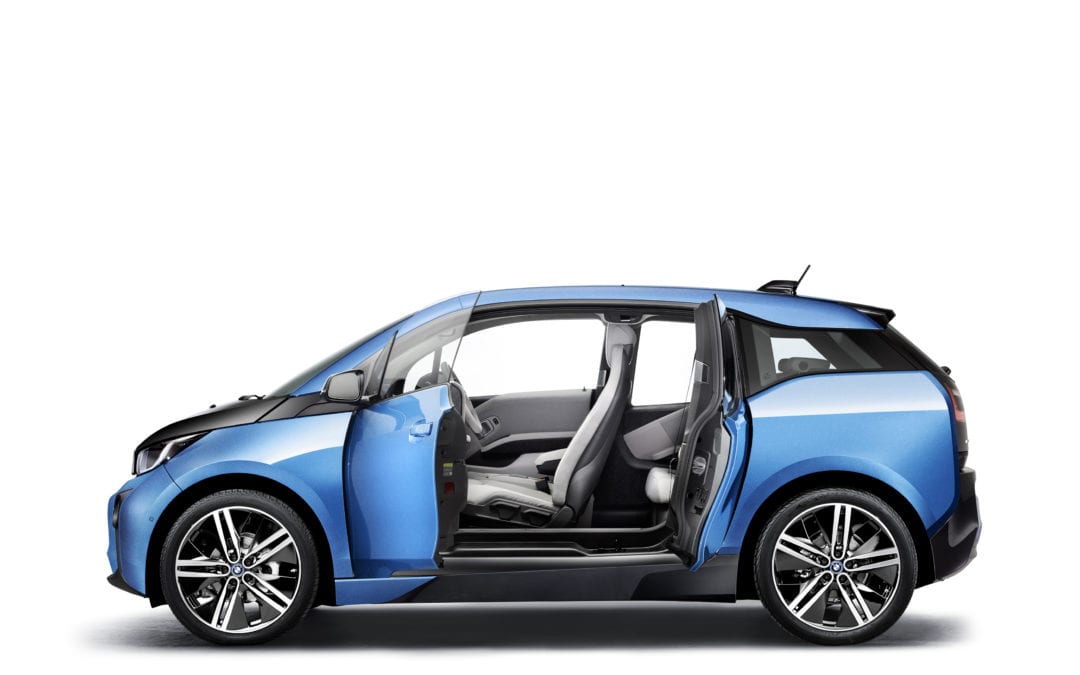
The big day has finally arrived for my first date with and Electric Vehicle. I am not sure if it is a good or bad thing that my first date with an EV is an award winning luxury model. Fosdick’s BMW provided me with a BMW i3 REx, the range extending version in the BMW i3 series. The REx has the same 22kWh battery as the BMW i3 (2016) EV but with a 647cc combustion engine providing 38hp fueled from a 12liter fuel tank, the same engine as in the BMW 650GT maxi-scooter. The usable battery capacity in the BMW i3 is 18.8kWh. But enough of the technical jargon lets focus on what really matters! The driving experience and making the mind shift to an EV.
One experiences the starkest difference between a “normal” combustion car and an EV the moment you start the engine. When you start the EV there is no sound at all, it is the weirdest experience, you feel uncertain if anything will happen should you step on the accelerator. A golf car makes more noise once you get going, however to all the petrol heads that jokingly refer to a BMW i3 as a glorified golf car I can certainly attest that it is not. If one must compare the driving experience at that level, it will be a Scalextric car. The BMW eDrive system provides powerful torque and the responsiveness is immediate from a standing start. Although with this type of driving you see your battery deplete very quickly. The driving experience is made even more direct thanks to the “one pedal feeling” that comes from a single pedal acting as both accelerator and brake. The low center of gravity provided by the heavy battery pack along the floor pan allows for superior handling.
One of the sales pitches that caught my ear was that there is no service required apart from tires and break changes, obviously with the caveat that the combustion engine in the REx needs servicing. If you consider that with the regenerative braking system much less breaking is required in traffic, resulting in longer lasting braking system.
The sales team was very knowledgeable and provided lots of detail on the car, but I would advise anyone that plans to purchase an EV to do their own homework also and ask relevant questions. For instance, does the package you purchase include fast charging, or is it optional? The BMW WallBox is also optional, BMW provides an assessment of your residents electrical system, which I will highly advise, but the WallBox comes with a high price tag. When I plugged the LV1 charger in my garage plug it tripped the electricity, after which I had to relay power from a plug point with higher amperage inside the house.
With the great tech included in the vehicle, the sales process is not just a “take the key and leave” affair. Connecting the vehicle to the BMW ConnectedDrive system unlocks a whole range of benefits and features. You can send reminders to buy milk or flowers from your laptop to your car or even active the horn, for what purpose I honestly don’t know. Back at my PC after showing the vehicle to some colleagues I was informed by the ConnectedDrive system that the passenger door was still unlocked. Comforts managed through the APP include Preconditioning, acclimatizing the vehicle for your preset departure time.
Through incorporating some gamification elements the APP measures your driving efficiency and compares it to the broader BMW i3 community, which leads to one’s natural competitive spirit kicking in, thereby successfully altering your bad driving habits. I actually ended up altering my route to suit the battery and become more efficient (I will explore battery management and increasing range in a separate post this week).
There are small technical things to take note of and get used to when driving the BMW i3 REx, like only being able to engage the range-extending mode once the battery’s state of charge (SOC) reaches 75%. A surprising thing is that you are not able to install a vehicle tracking system. However with all the connectedness I believe finding the car would be very much like “Find My iPhone”. Opening the fuel tank also requires a certain sequence due to the fire danger associated with the lithium batteries.
I can conclude that my first impressions of the BMW i3 and EV’s are lasting impressions, of the good kind. I already dread the day when I have to go back to a “normal” car. At least I can look forward to a couple of more days with the BMW i3.

Contributor
Wynand studied his MBA in San Francisco where he was exposed to the fields of Service Science, Gamification, and Renewables, which he combined to create wattEV2buy and the award winning web app Ekoguru. Wynand is an energy storage expert and has modeled, designed and presented various solutions utilizing lithium-ion and other electrochemical technologies. In his spare time, Wynand is the author of a children’s book series and started a new project called “Career 180”.

Range anxiety is probably the most common hurdle to overcome for all new Electric Vehicle (EV) owners or prospective owners. Terms like “bricking”, used when your EV is as useful as a brick when running out of energy on the highway springs to mind. Well, I can certainly attest to the fear associated with range anxiety. I am test-driving my first EV next week, an awesome BMW i3, sponsored by the friendly folks at Forsdicks BMW Tygervalley.
The fear is keeping me up at night and remains with me in my waking hours over the last couple of days. The only time I experienced range anxiety in a diesel vehicle was when we took a safari in Botswana. We trekked for 3 weeks with no fuel available in a 600mile radius, and the fuel that was available was not of the required quality, clogging my fuel filter on the way back to Cape Town. But situations like that are extreme for most vehicle owners and they have to cast their minds back to a time when they were students to recall what range anxiety felt like. Having to fuel with the couple of cents that was left after a night out.
Questions like how far the distance between my office and home is, or how would rush hour traffic influence the vehicle’s range, consume my mind. Suddenly I also remember that the power in my house was not of the right amperage for the coffee machine I bought. At the time I did not know what it meant because I failed woodwork with Julius Malema. Now it’s all coming back to me, and I fully understand what amperage is, and that I sold the coffee machine for a reason – not having an amperage of 20amps on the plug points.
When I Googled “car charging stations in cape town” I had to scroll down on the result page, past Cape Cod and some other “Town’s” to find out that there are some in South Africa, being built in Sandton, a cool 1400km (875 miles) from where I live. How I wish I were back in San Francisco, where you had a better chance of finding a charging station than a petrol station in the city. When I did the calculations the BMW i3 would be perfect for my situation, it has a 128km (80 miles) range, which is more than enough for the 36.4km ONE WAY I have to travel to and from town. Suddenly my fear is amplified, as I realize it is equal to nearly 80km a day. What happens if the car is not fully charged when I leave home in the morning? I am also acutely aware that it is winter, and a battery loses its charge quicker in the cold.
Getting back to reality, and my date with a cool BMW i3 tomorrow. I recently read that a study by the US Department of Transport found that 95% of all single-trip journeys is below 50km (30 miles) and 98% below 80km (50 miles), with only 1% above 112km (70 miles). So it is clear that the vehicle manufacturers all targets this sweet spot with Tesla setting the benchmark on the longer distances, with a 400km (250 miles) distance.
I can also take comfort in the fact that BMW, the largest vehicle manufacturer in the world and its clever engineers will not design a product that will leave its driver’s with a car that is as useful as “brick”.
All I need to do to make the next week a great experience is to have a mind shift, from how vehicles were used up to now to how vehicles would be used from now into the future.
Follow my experience as a new EV driver with the BMW i3 over the next couple of days on wattEV2buy.com and join the revolution.

Contributor
Wynand studied his MBA in San Francisco where he was exposed to the fields of Service Science, Gamification and Renewables, which he combined to create wattEV2buy and the award winning web app Ekoguru. Wynand is a energy storage expert and has modeled, designed and presented various solutions utilizing lithium-ion and other electrochemical technologies. In his spare time Wynand is the author of a children’s book series and started a new project called “Career 180”.